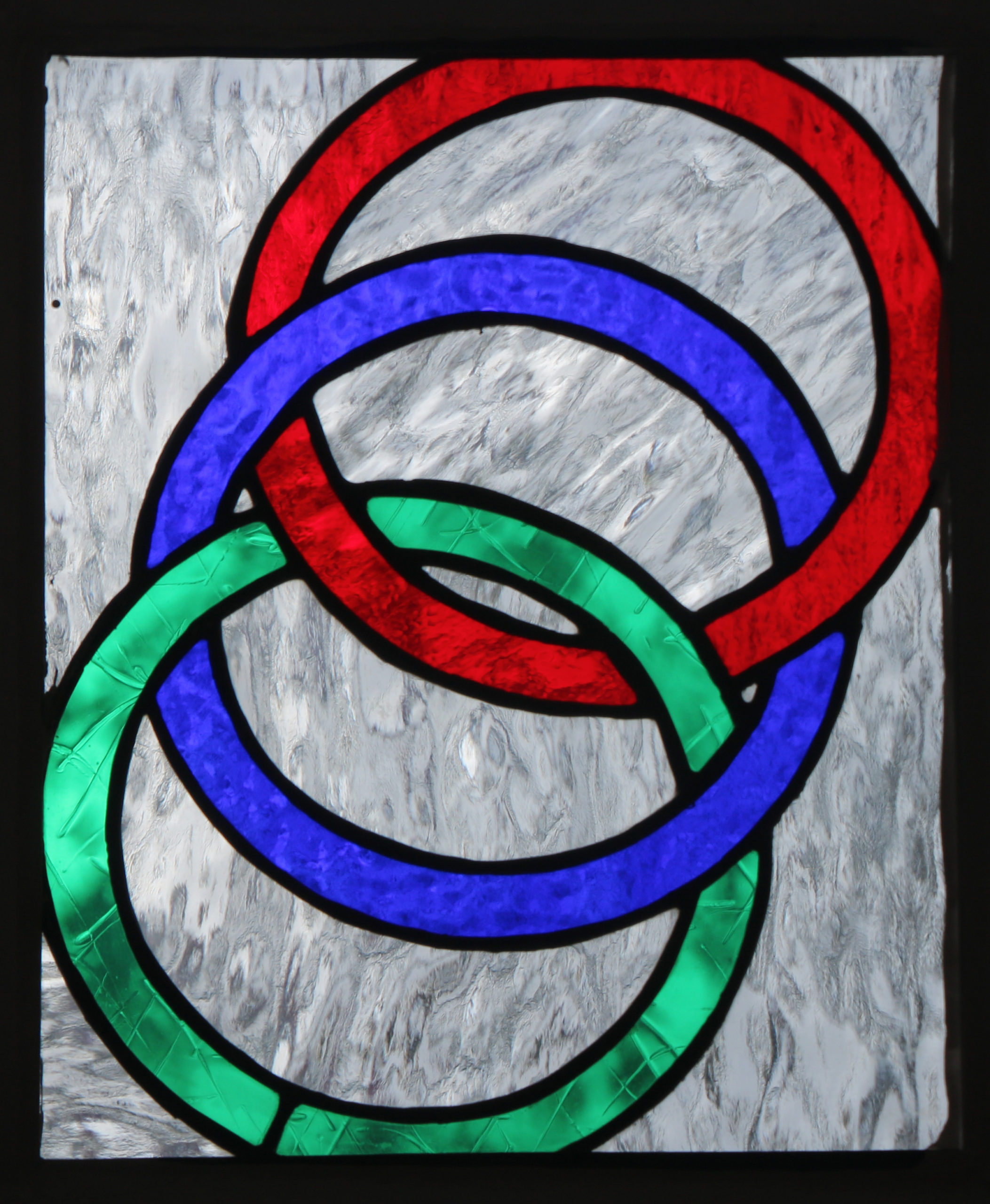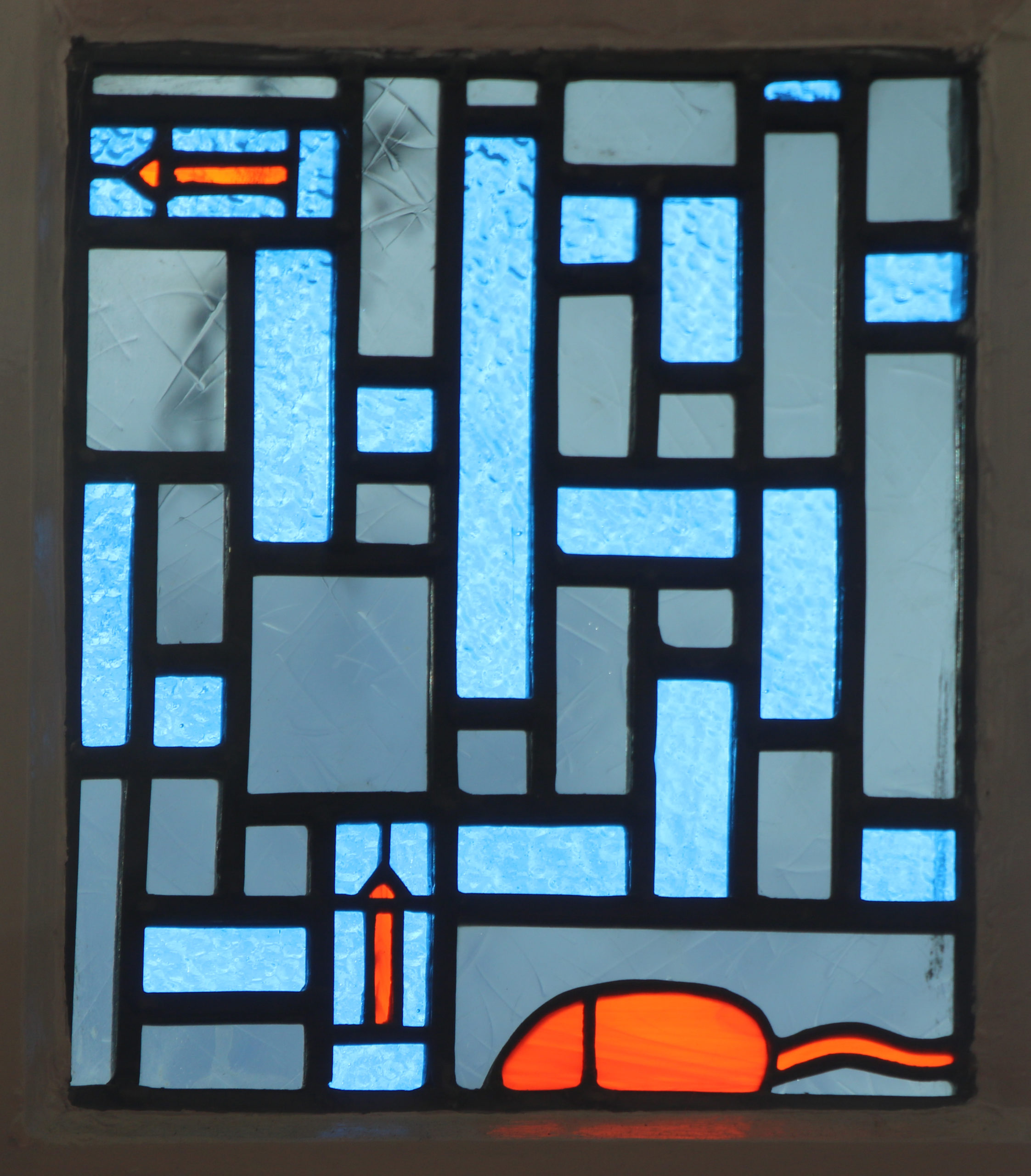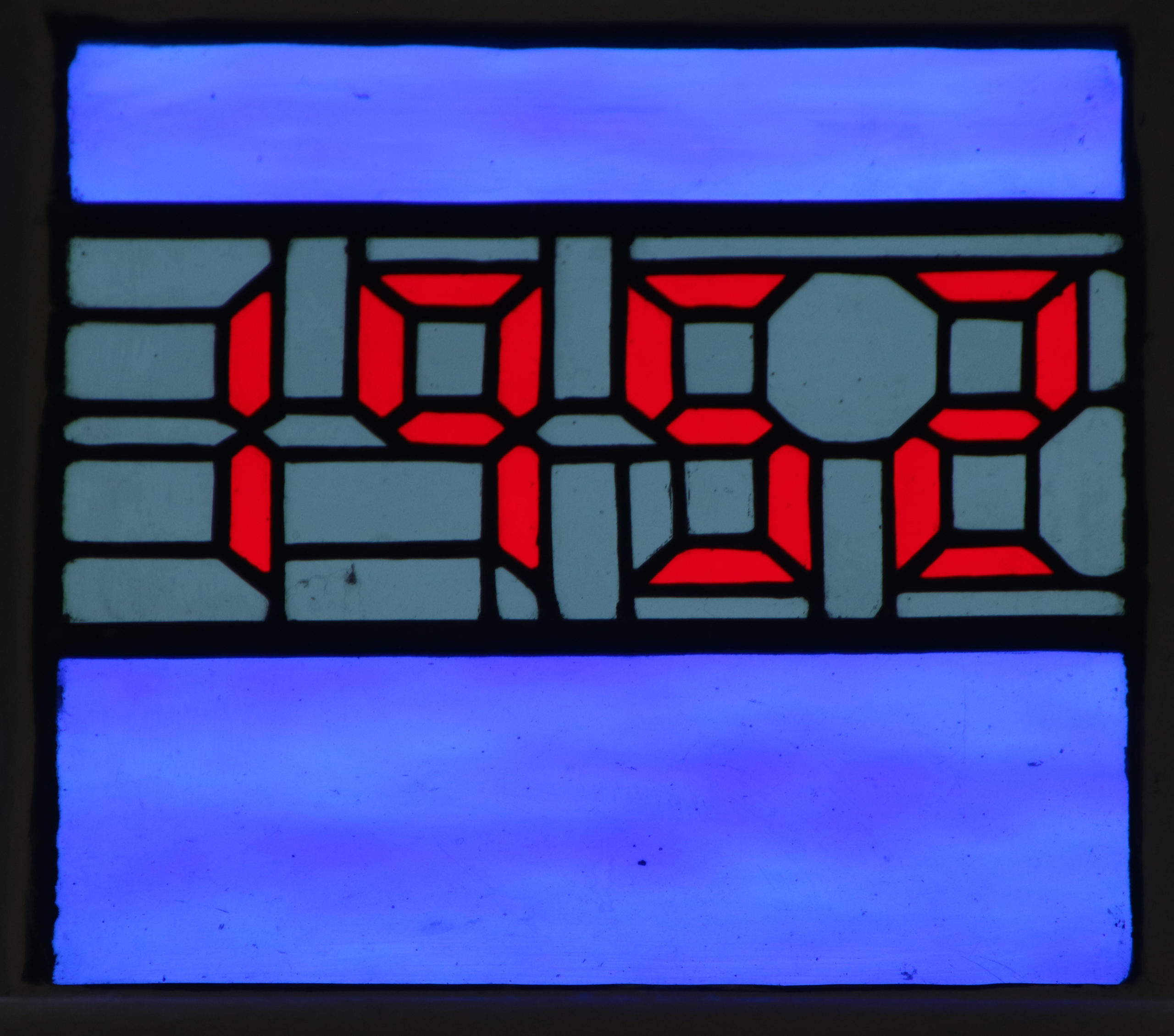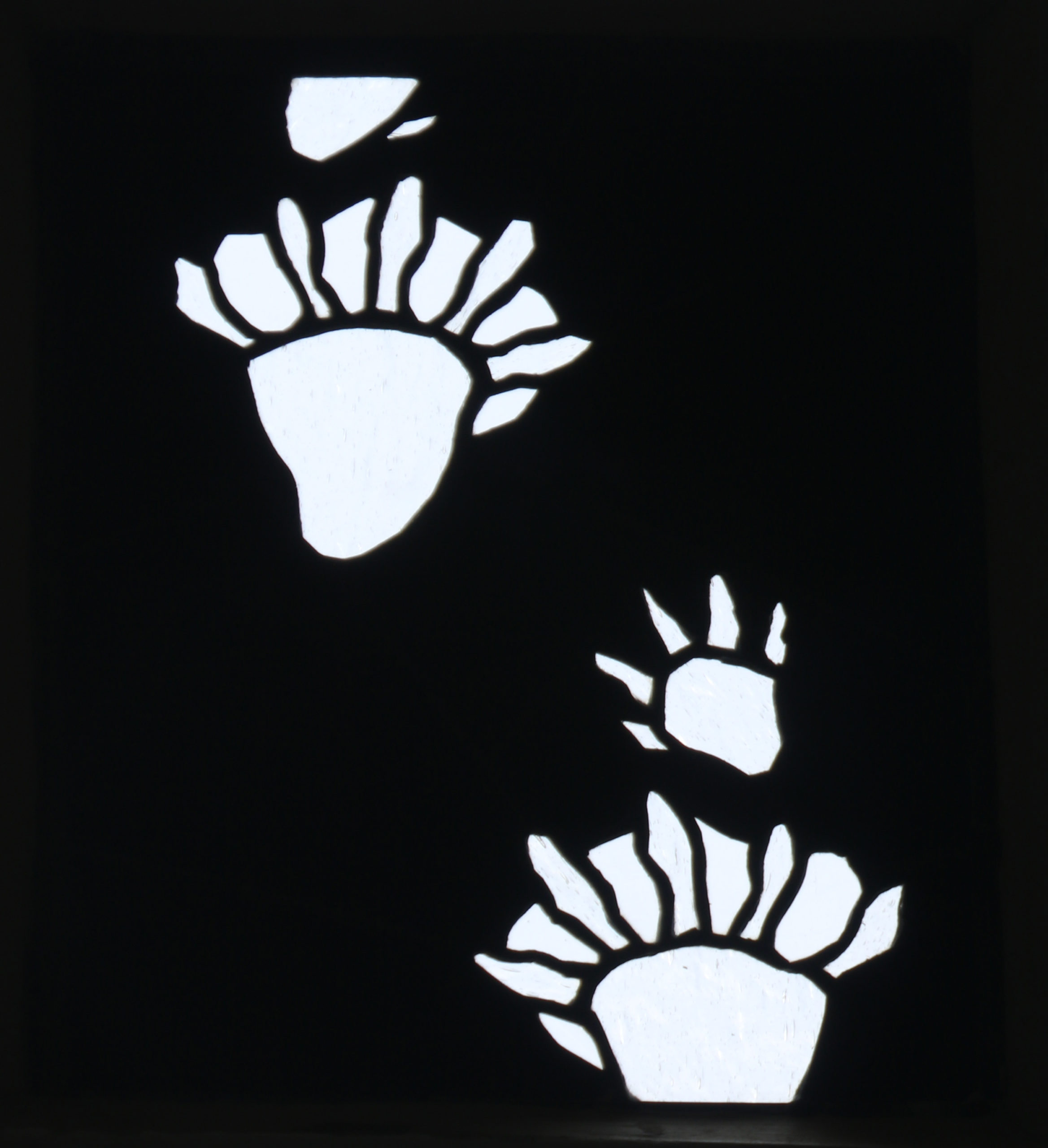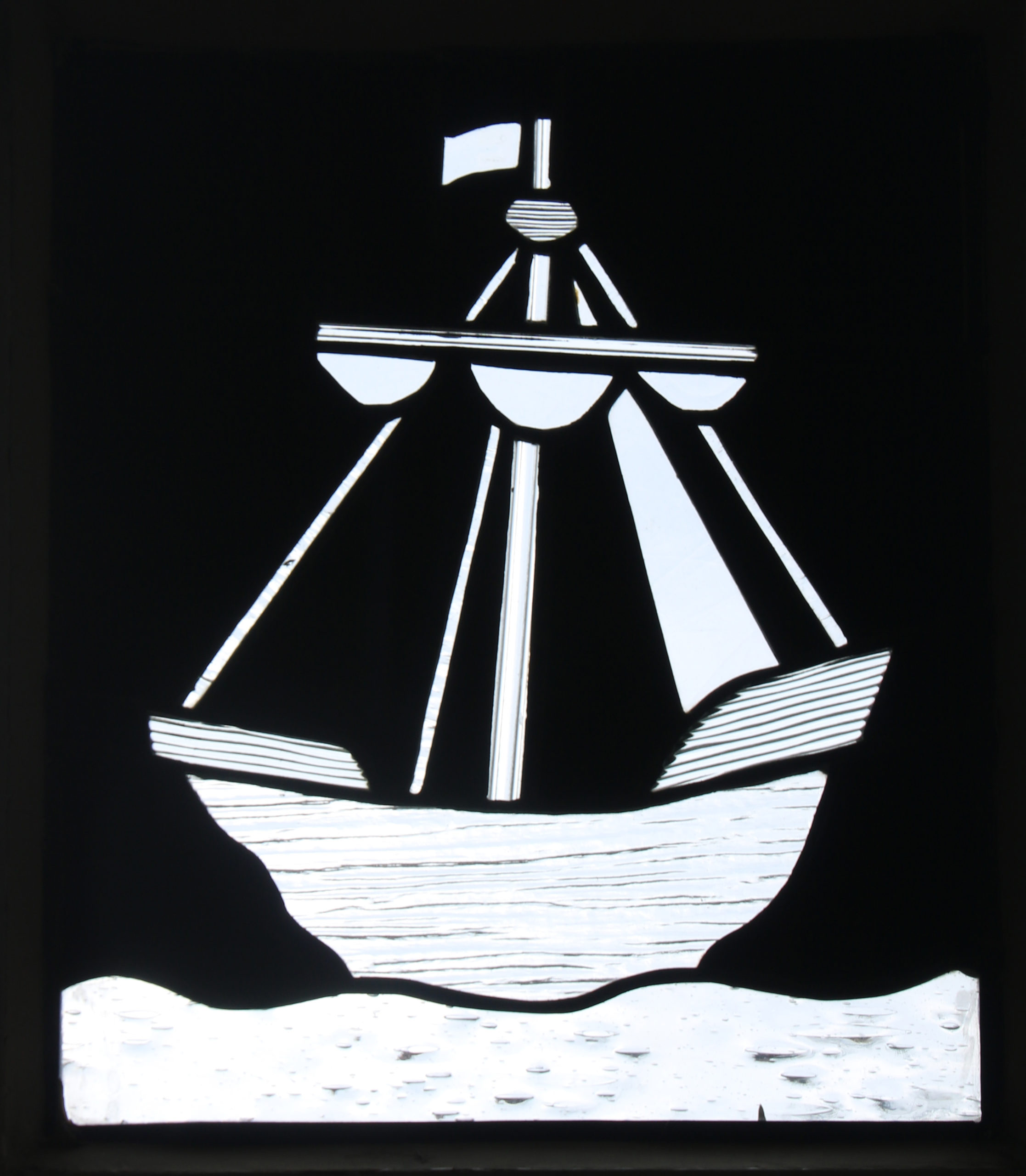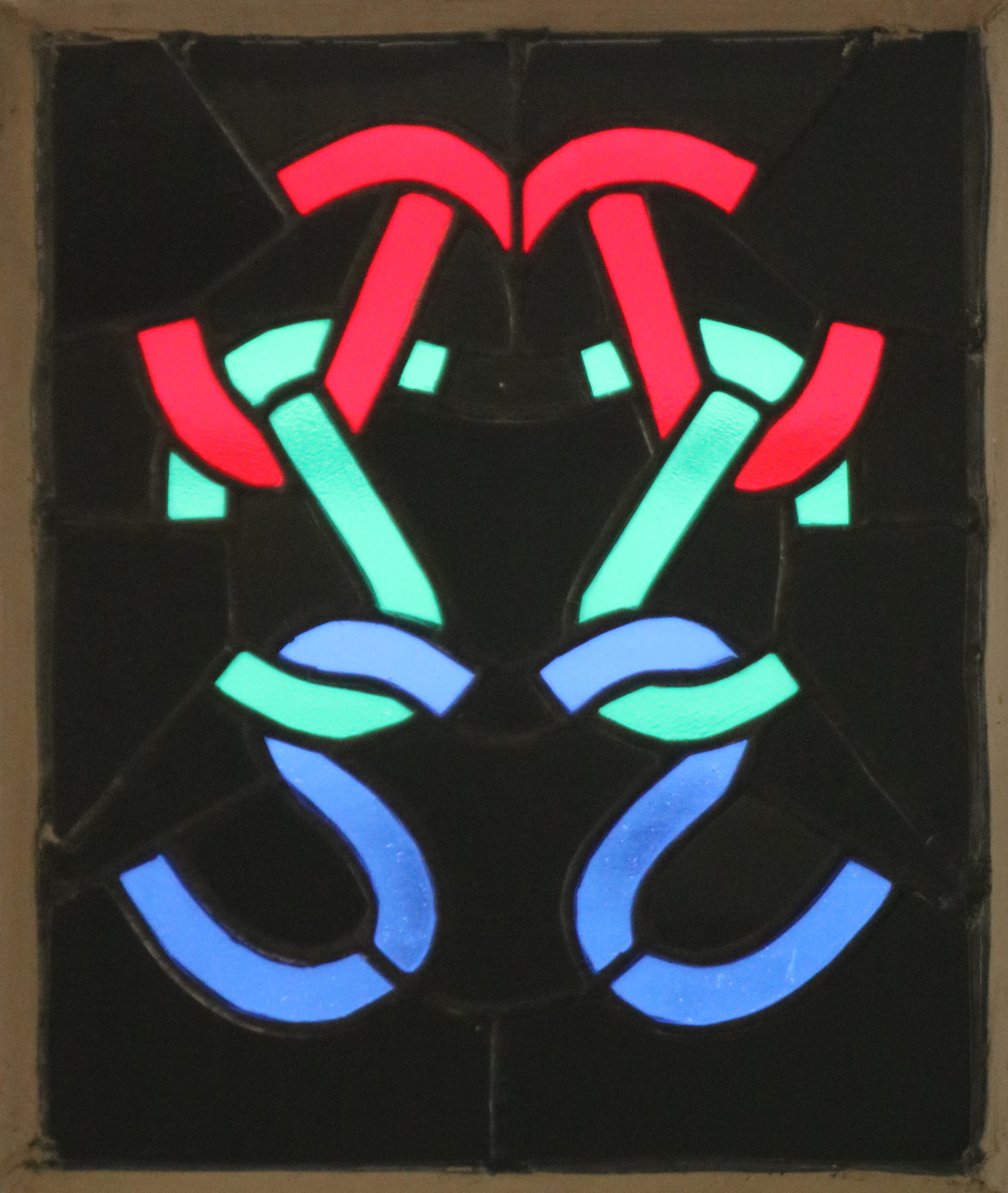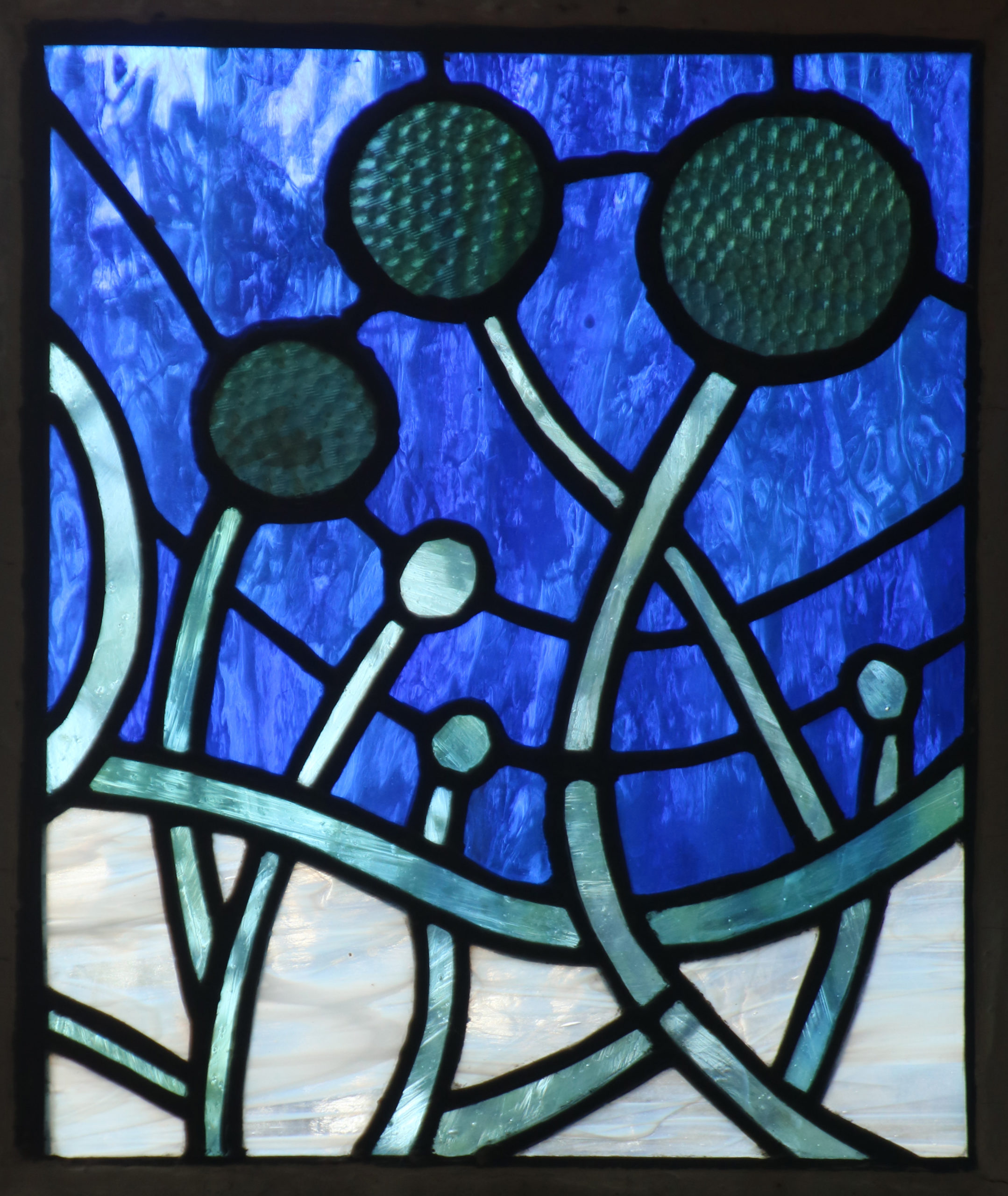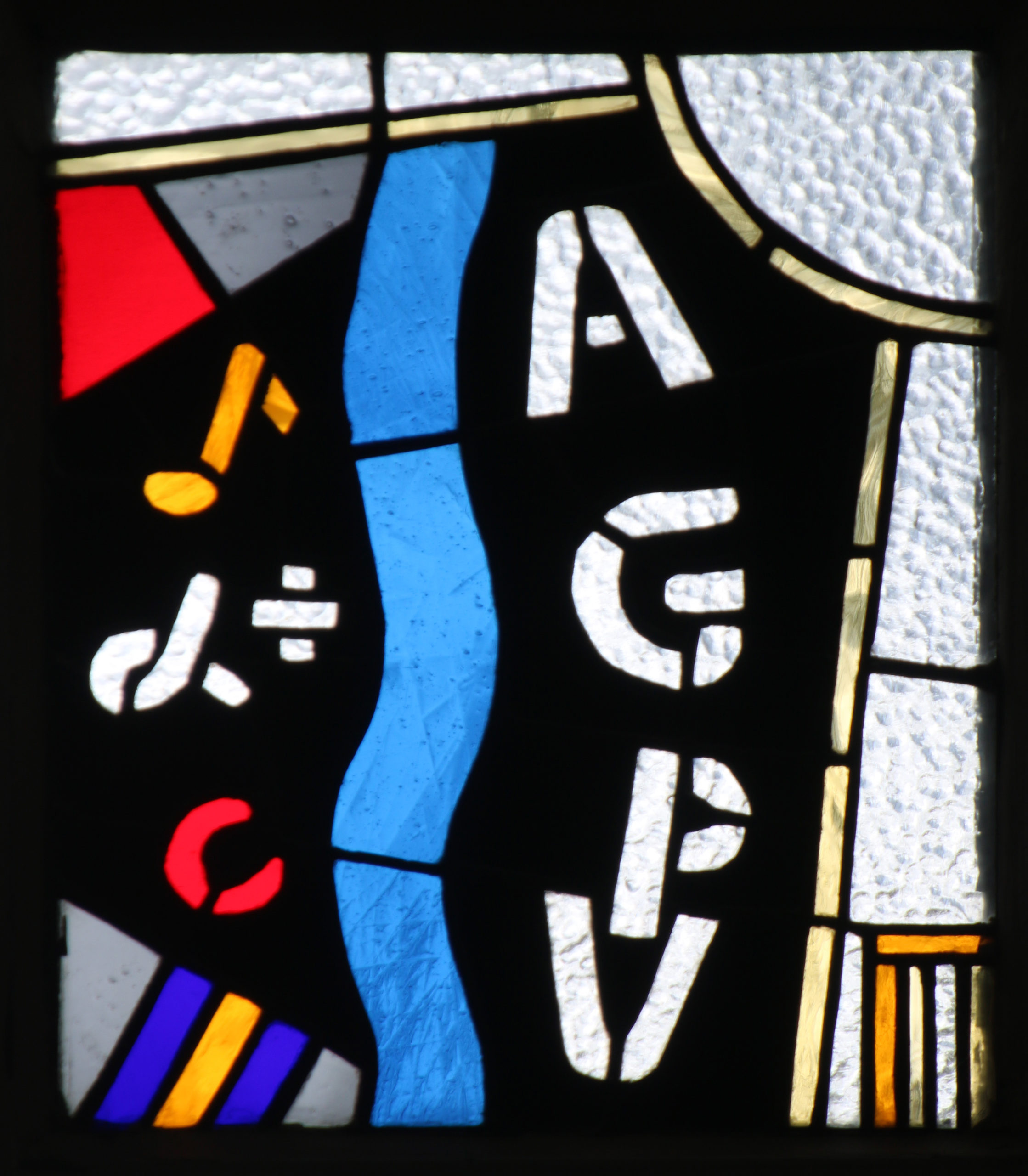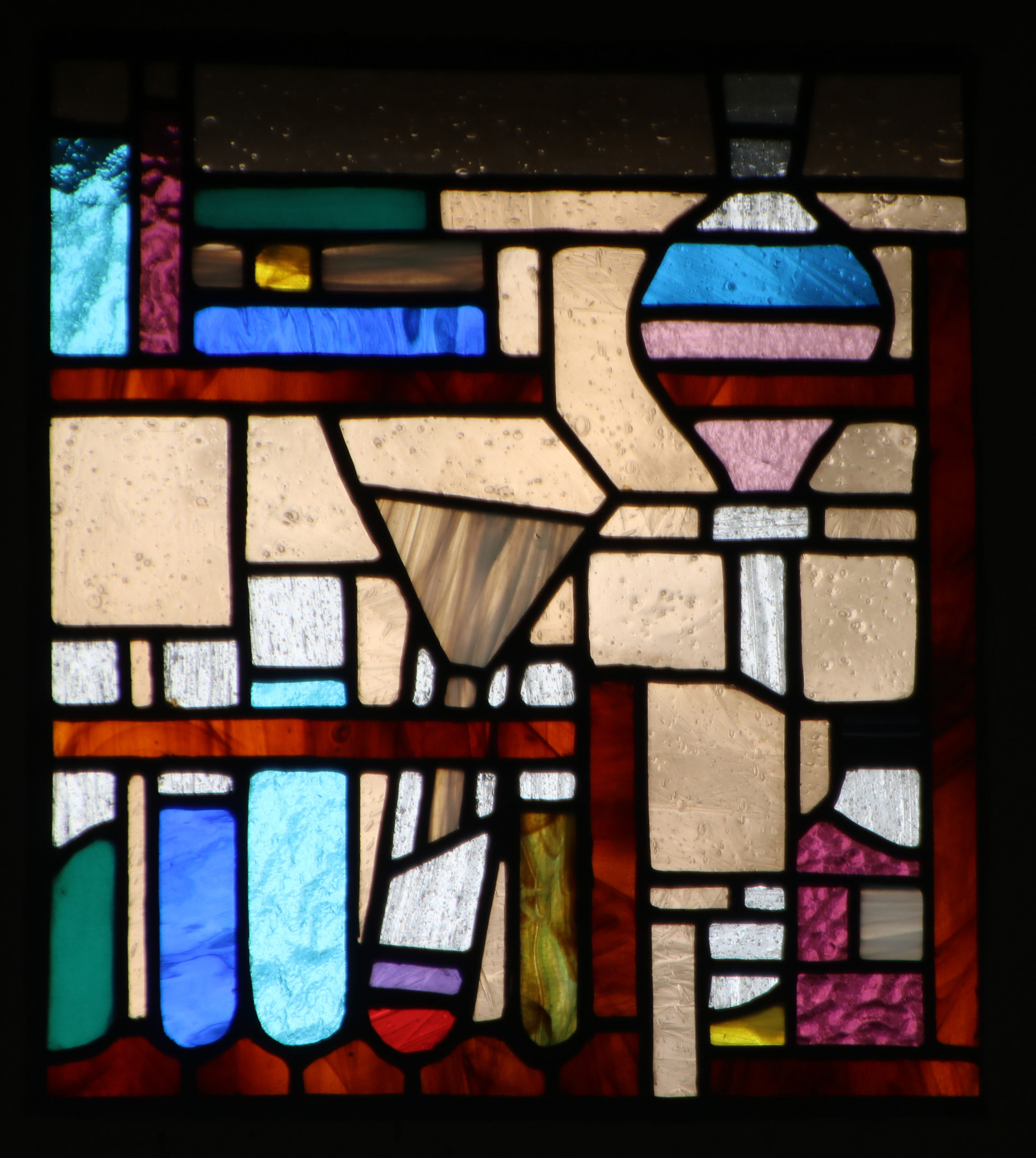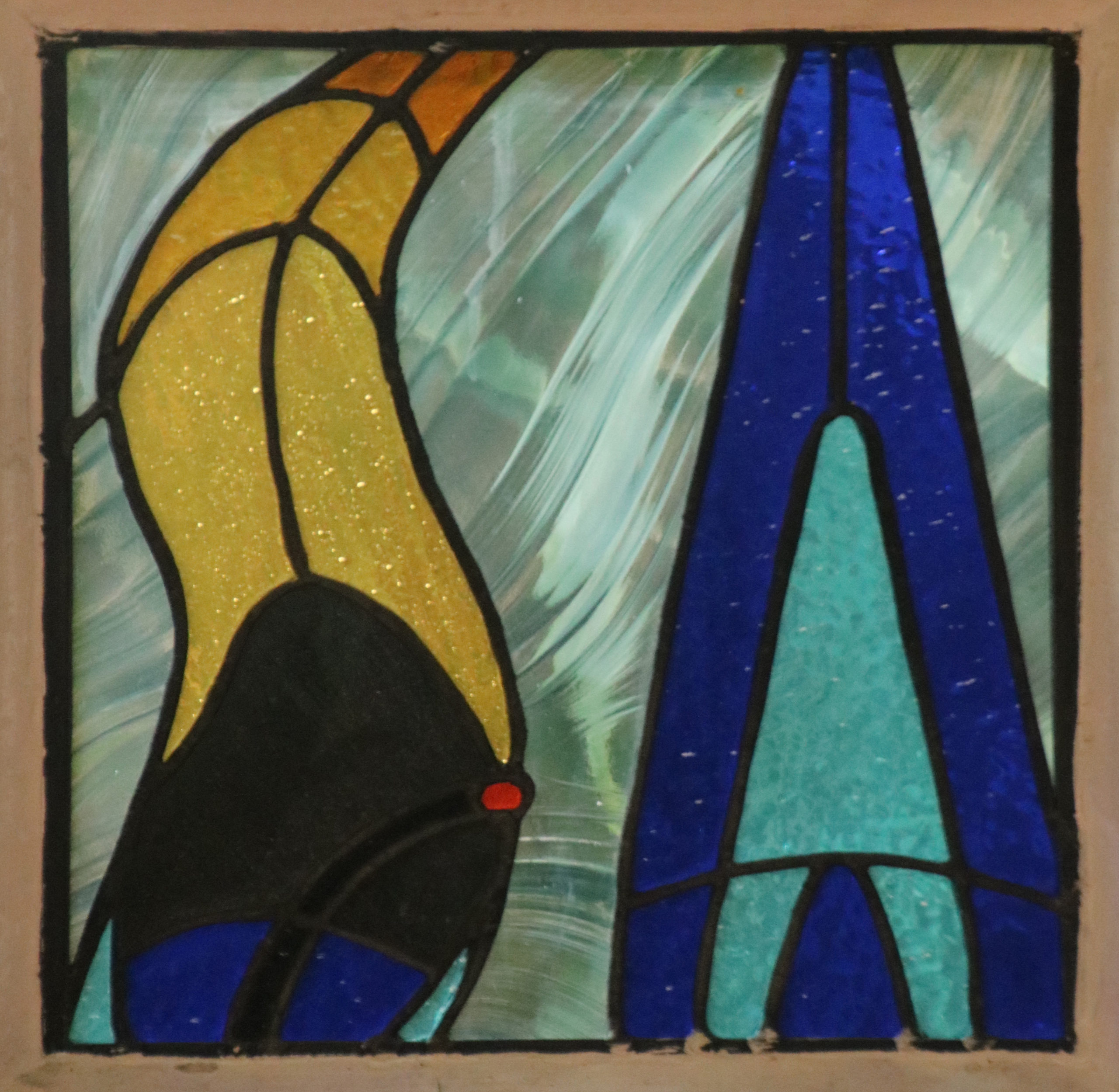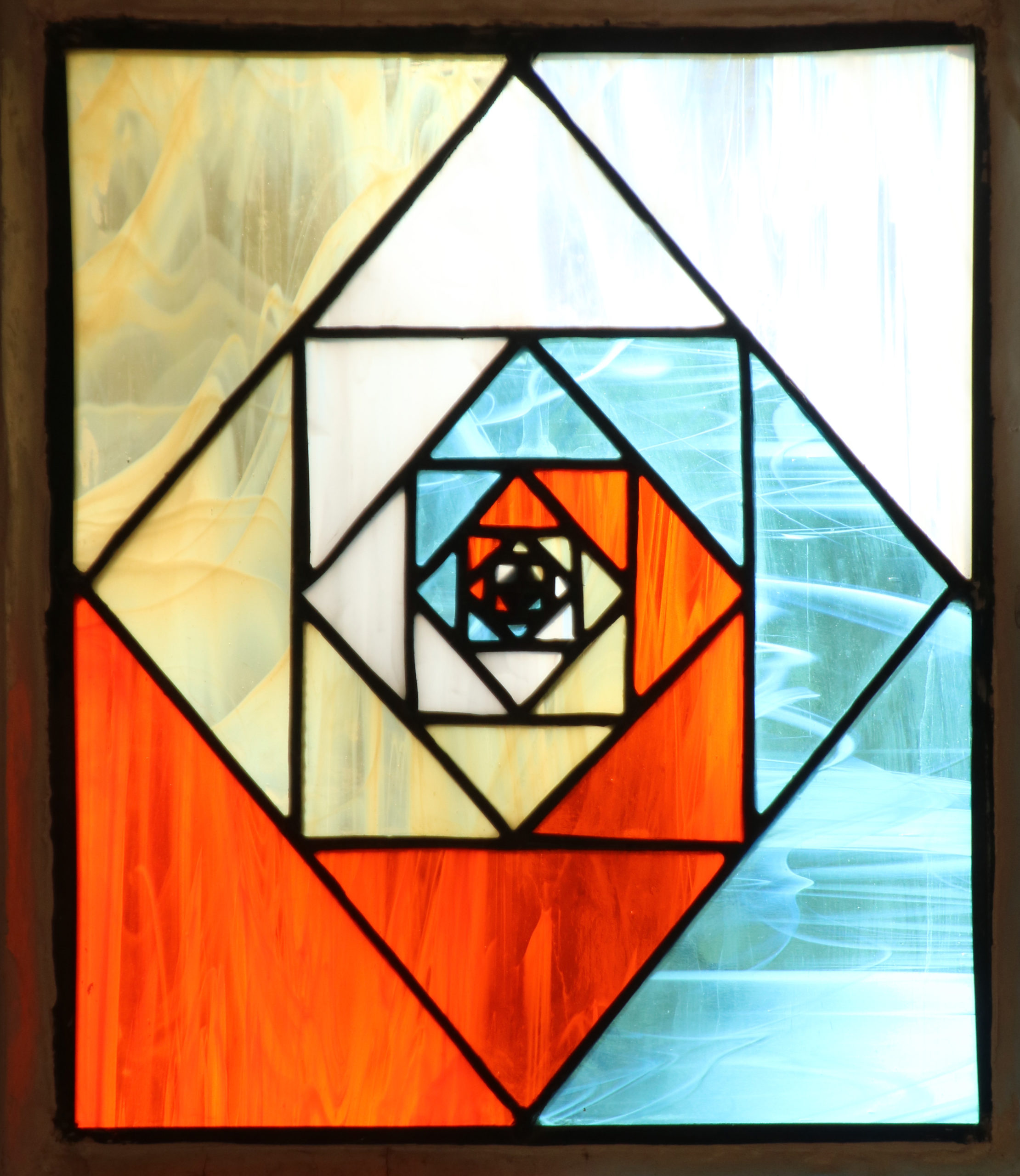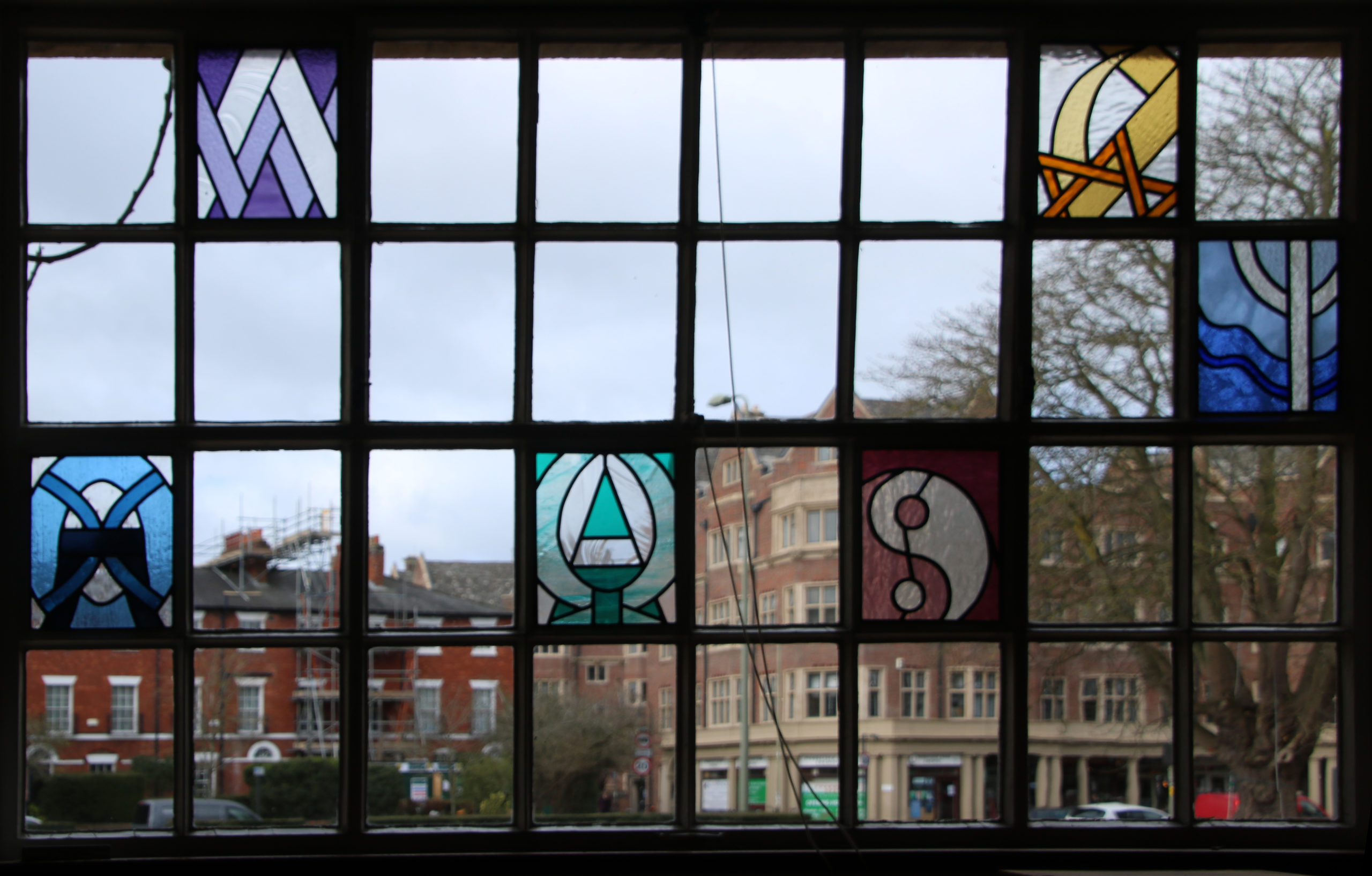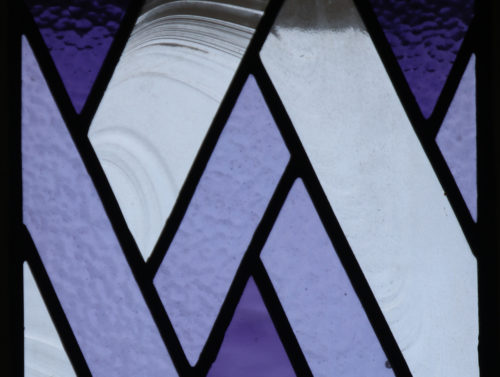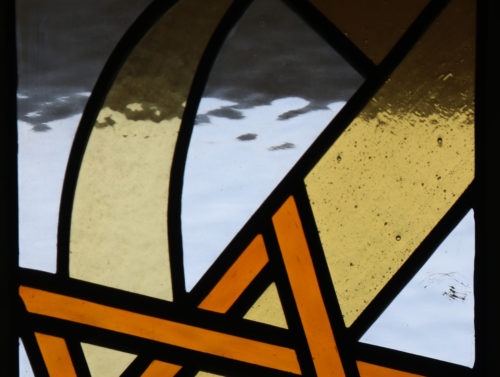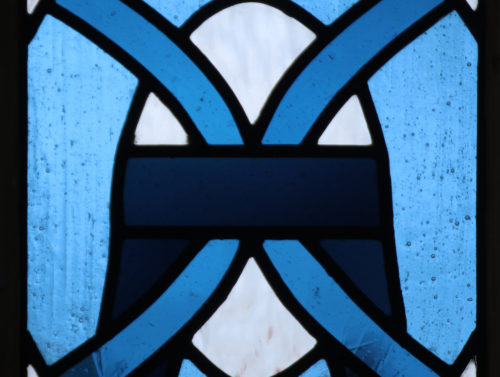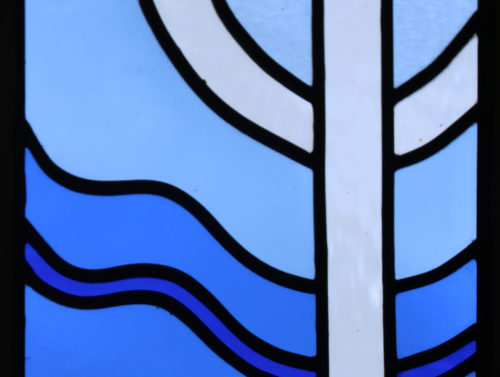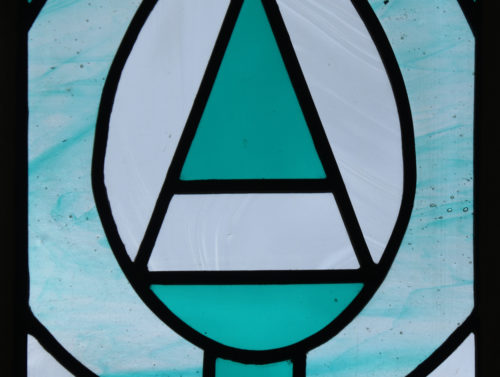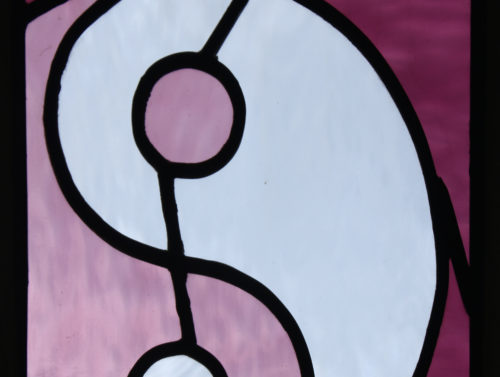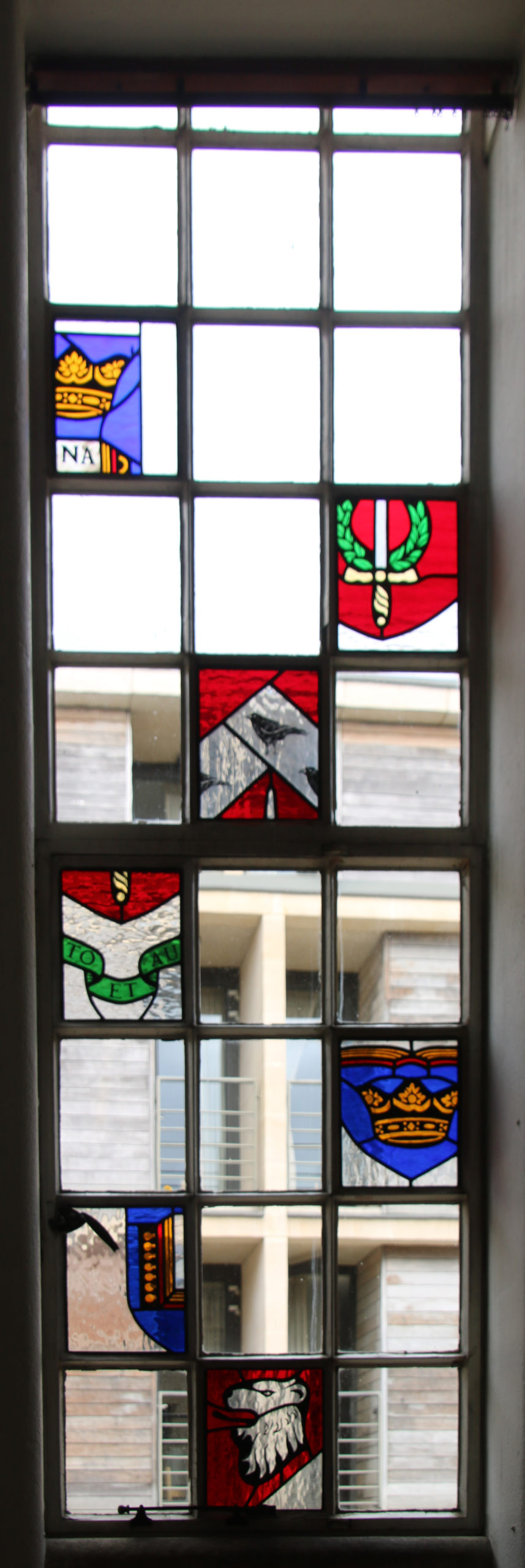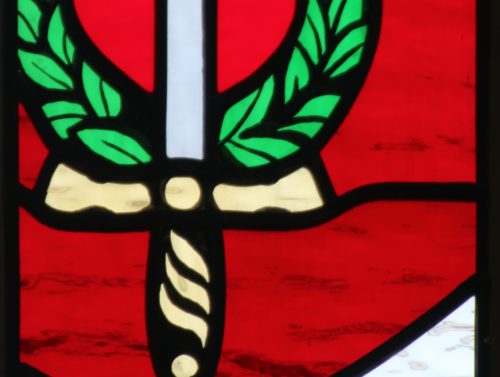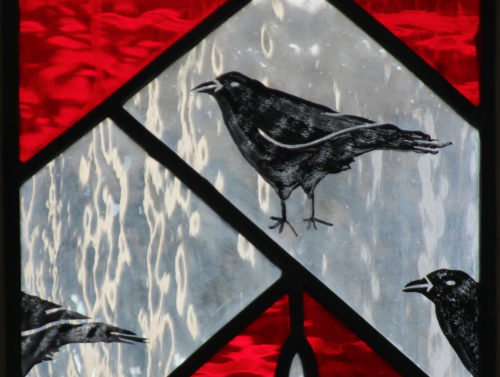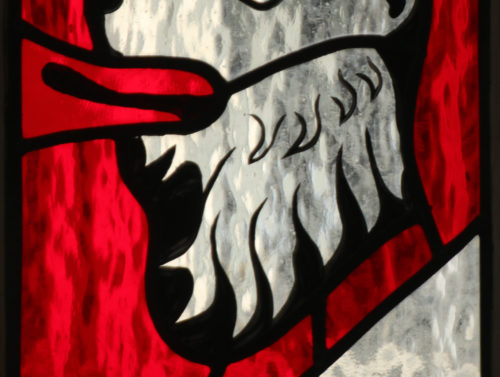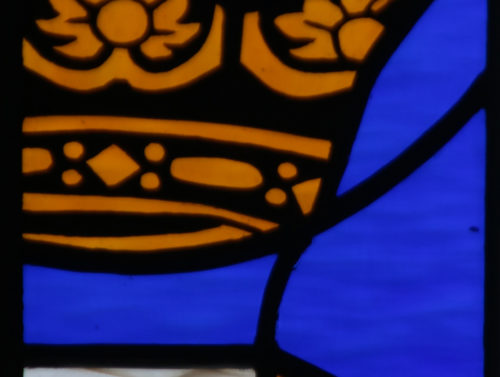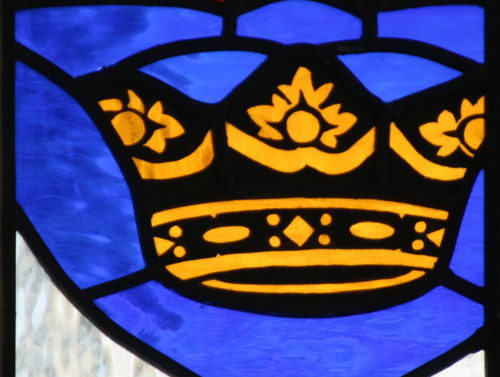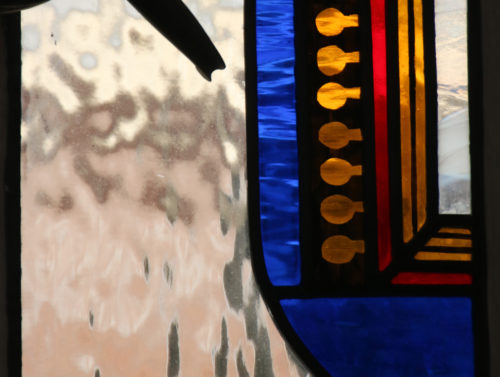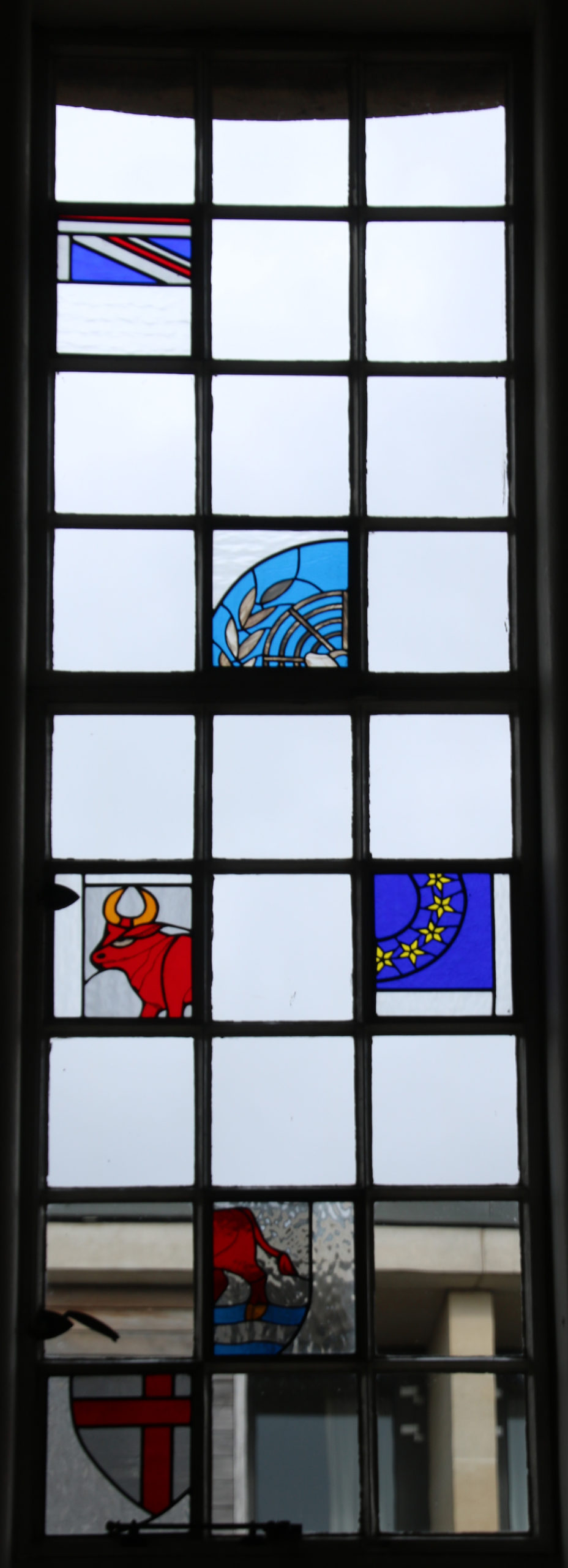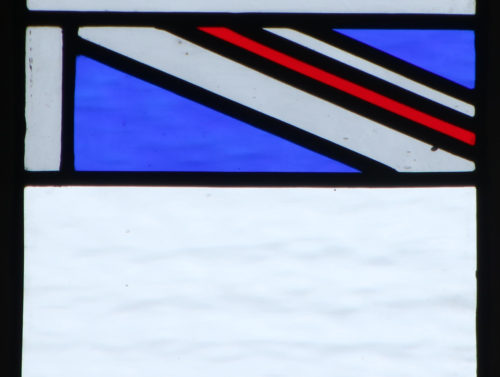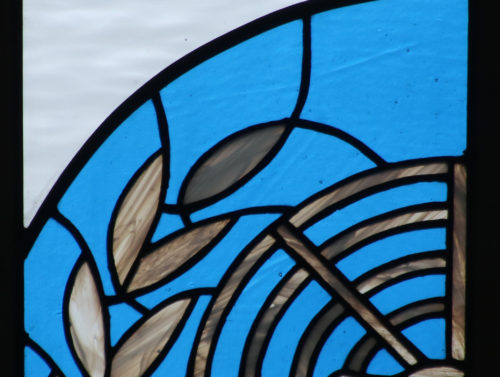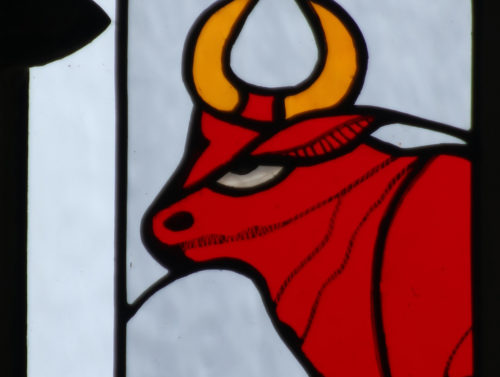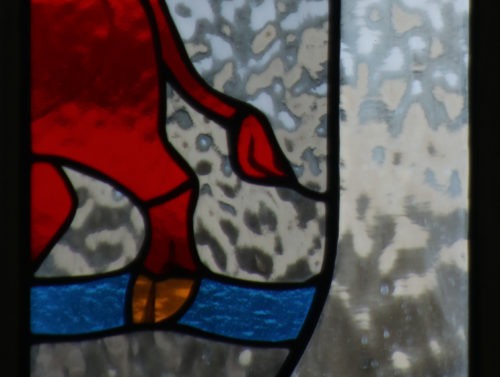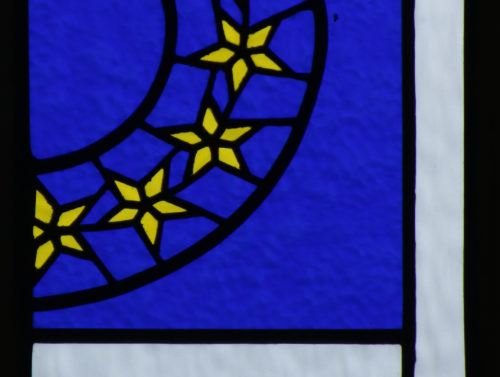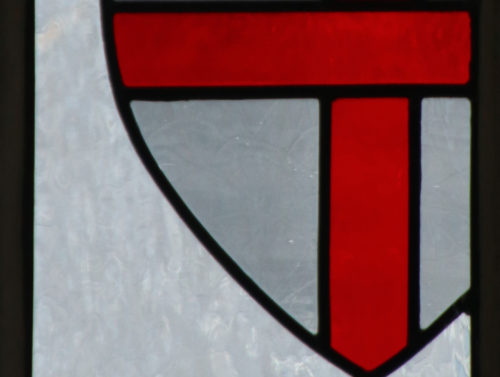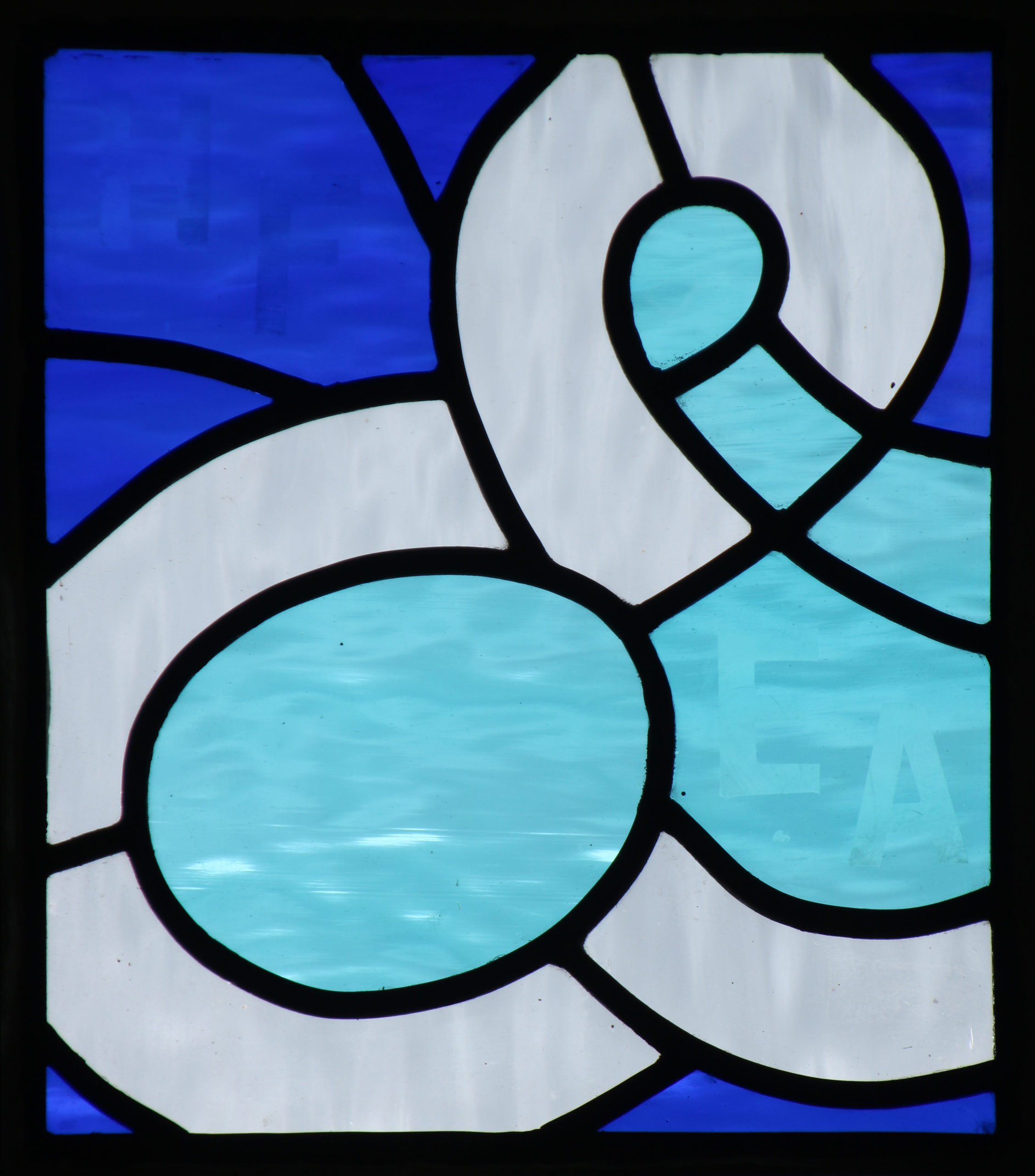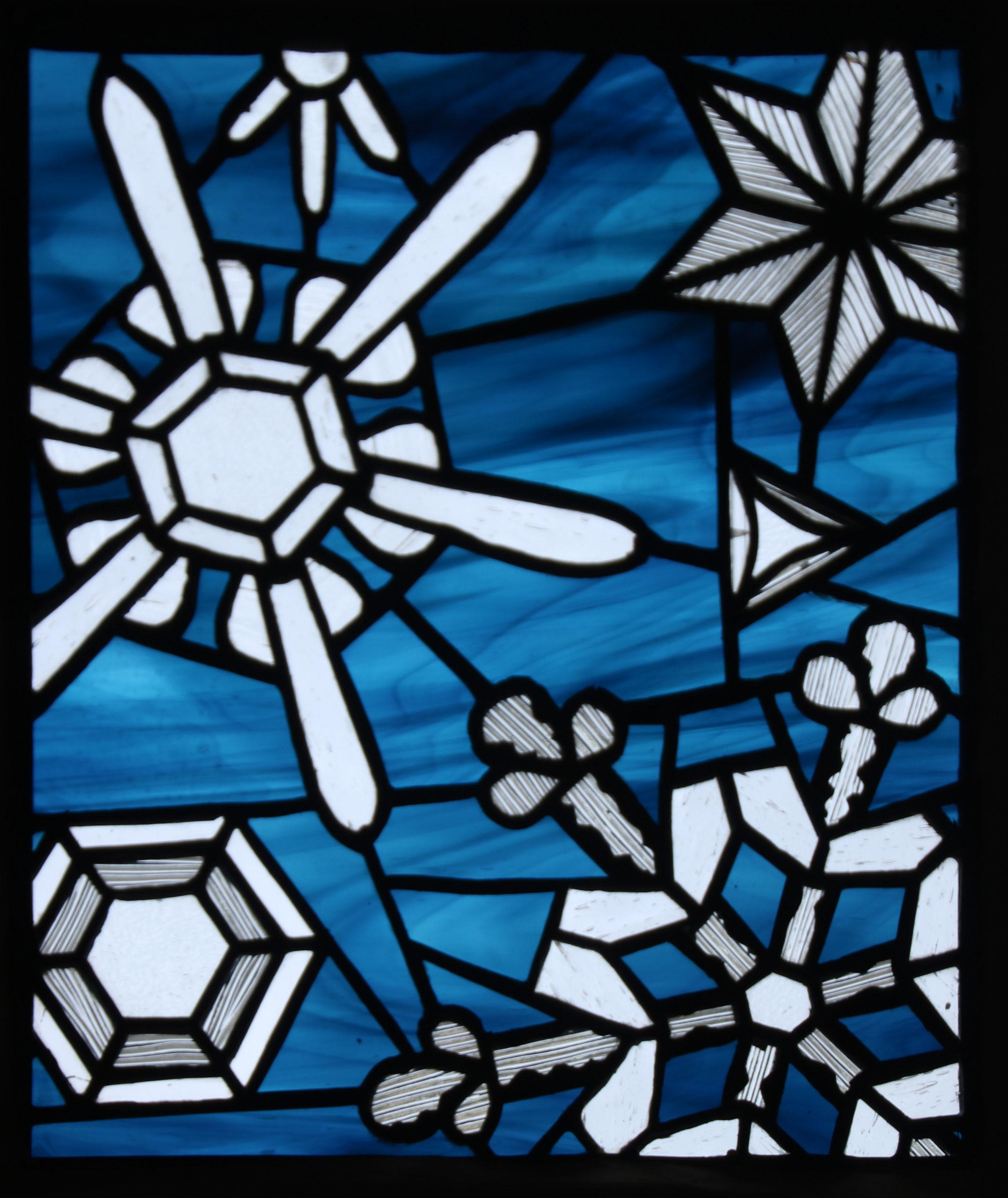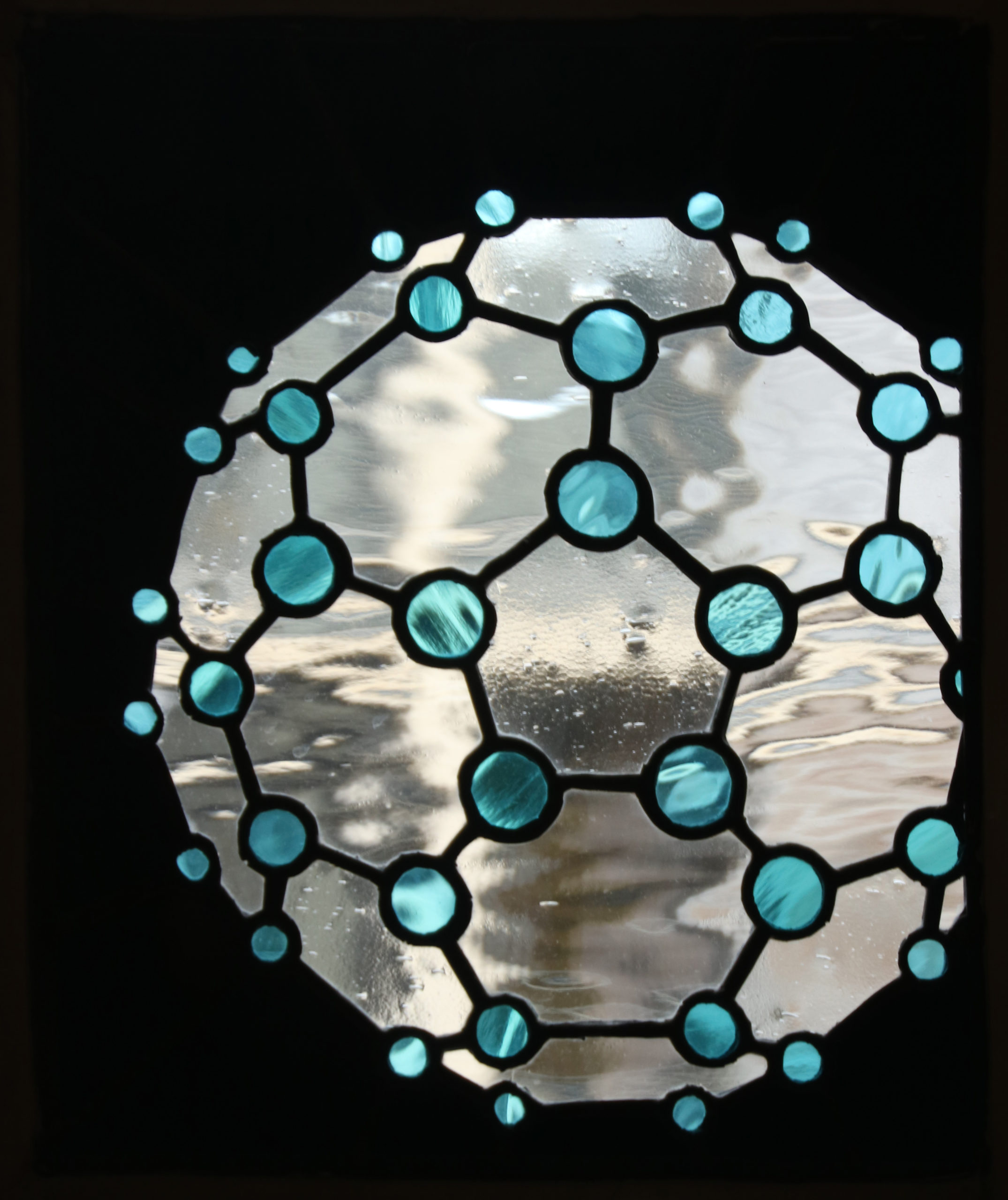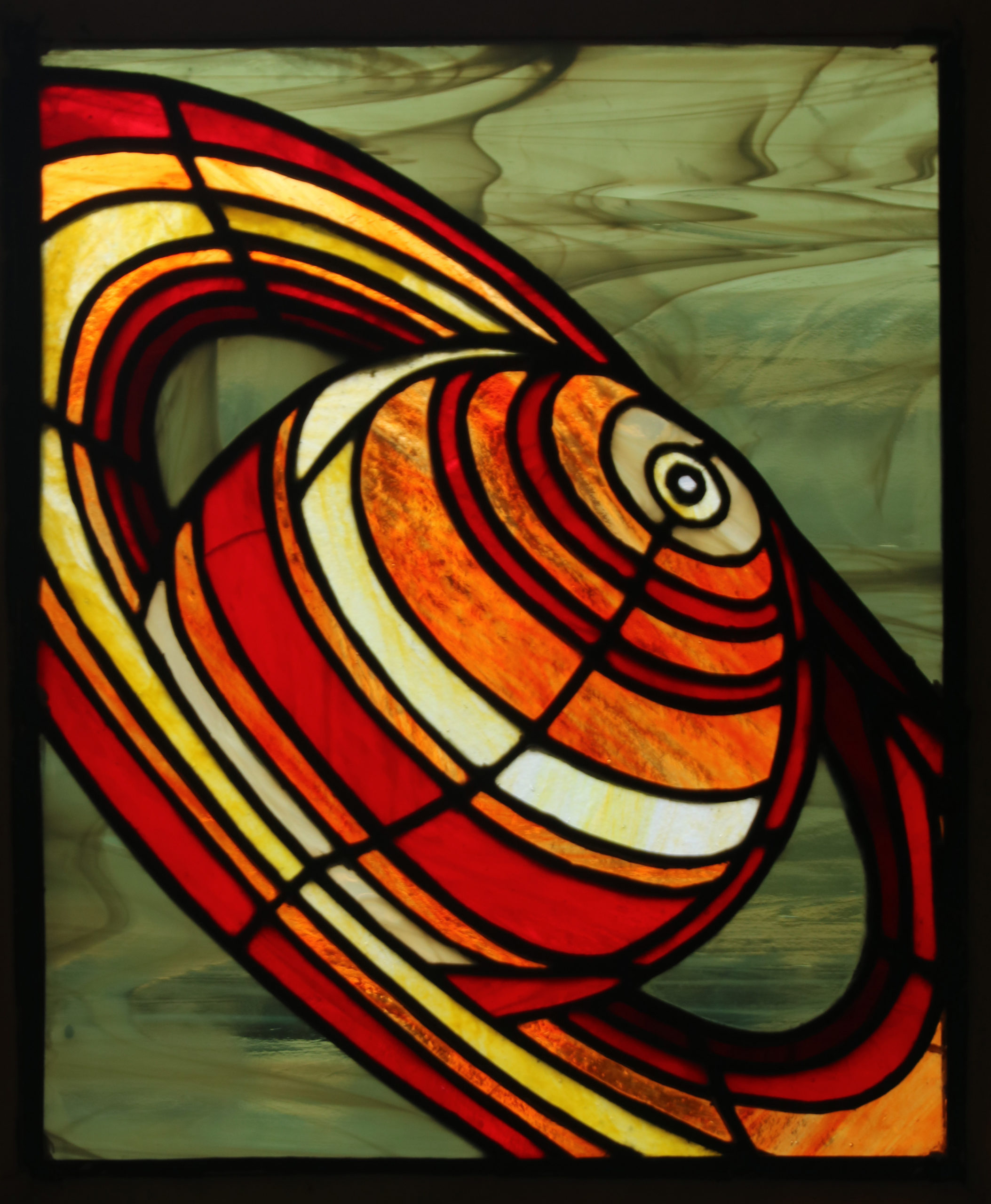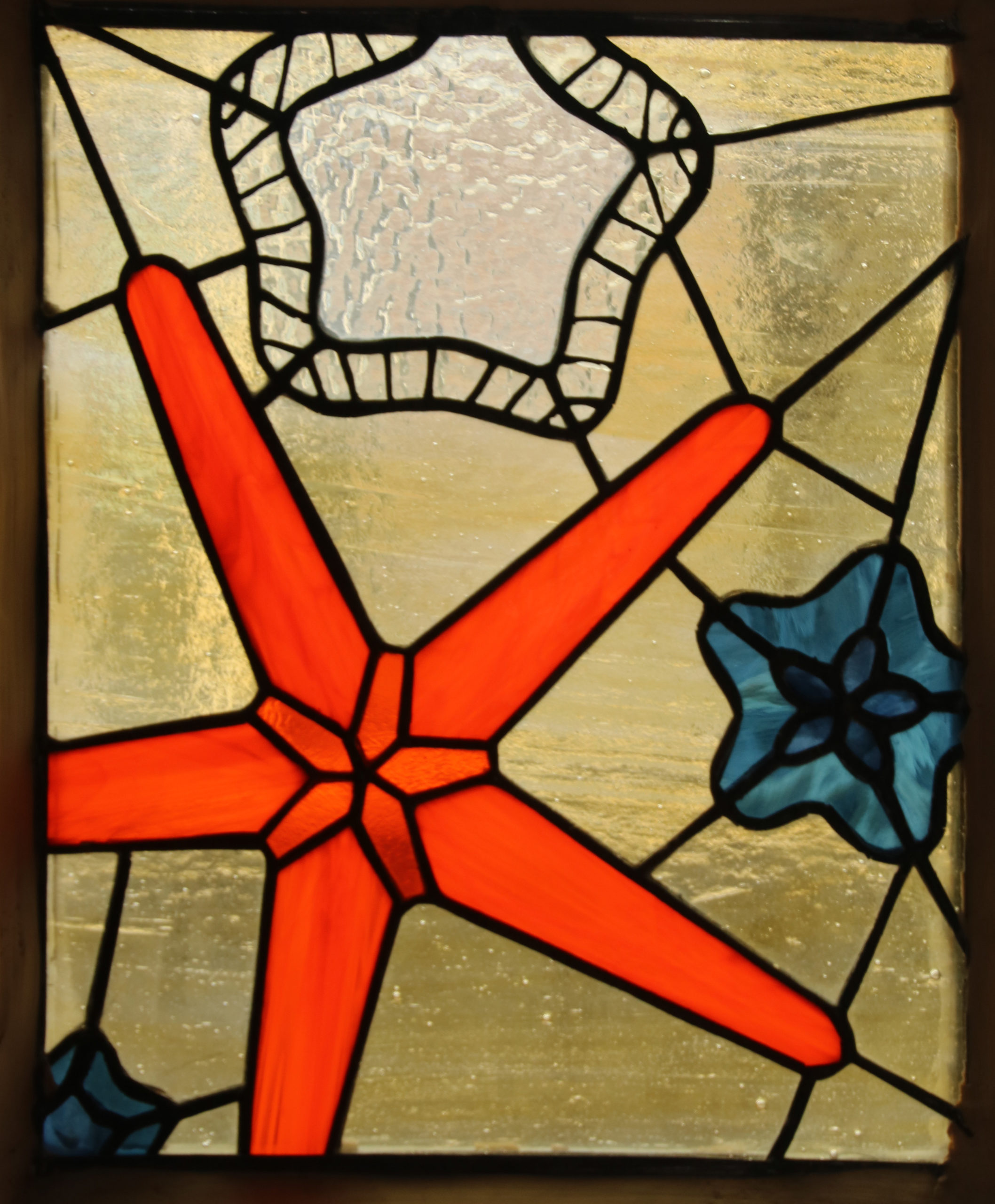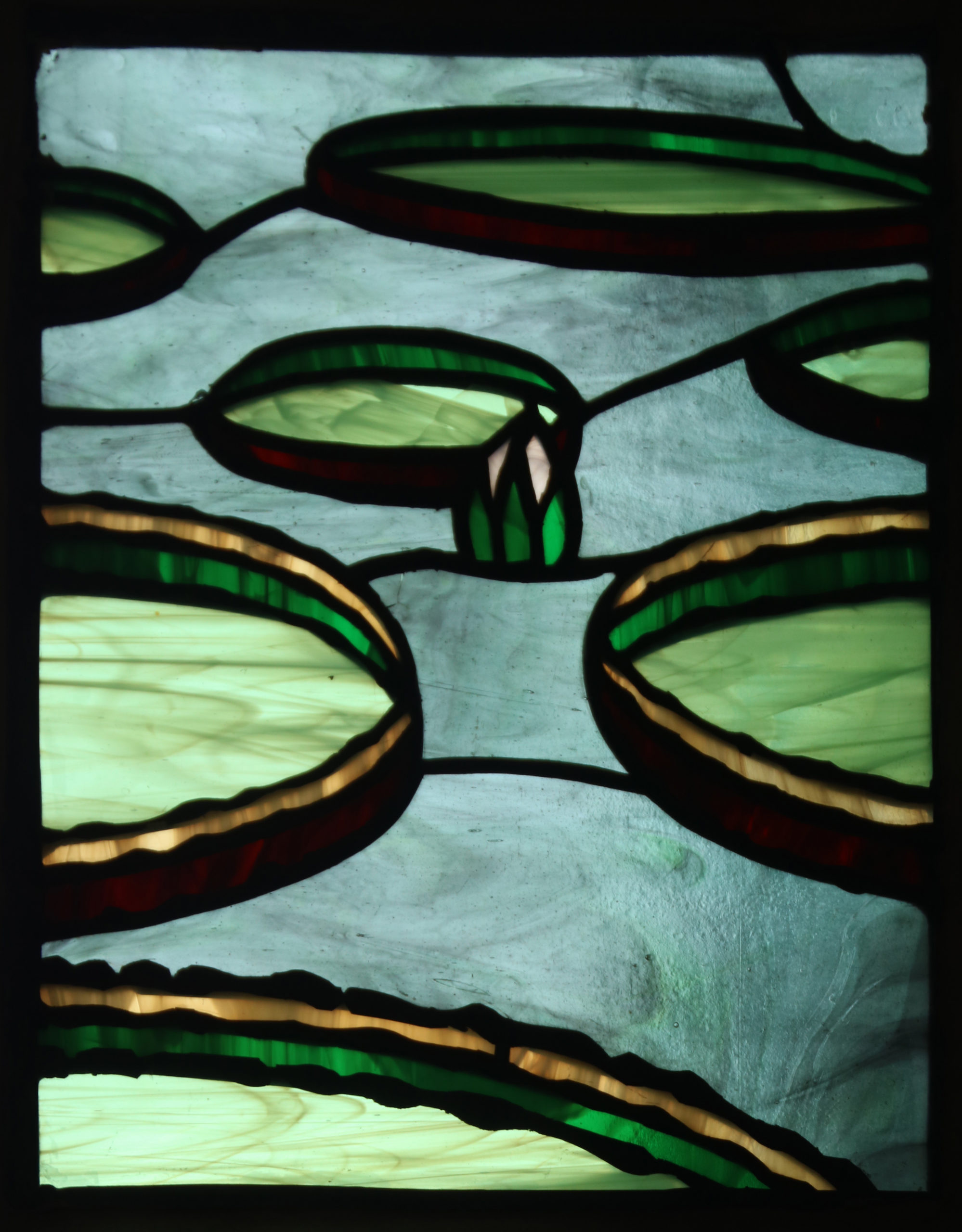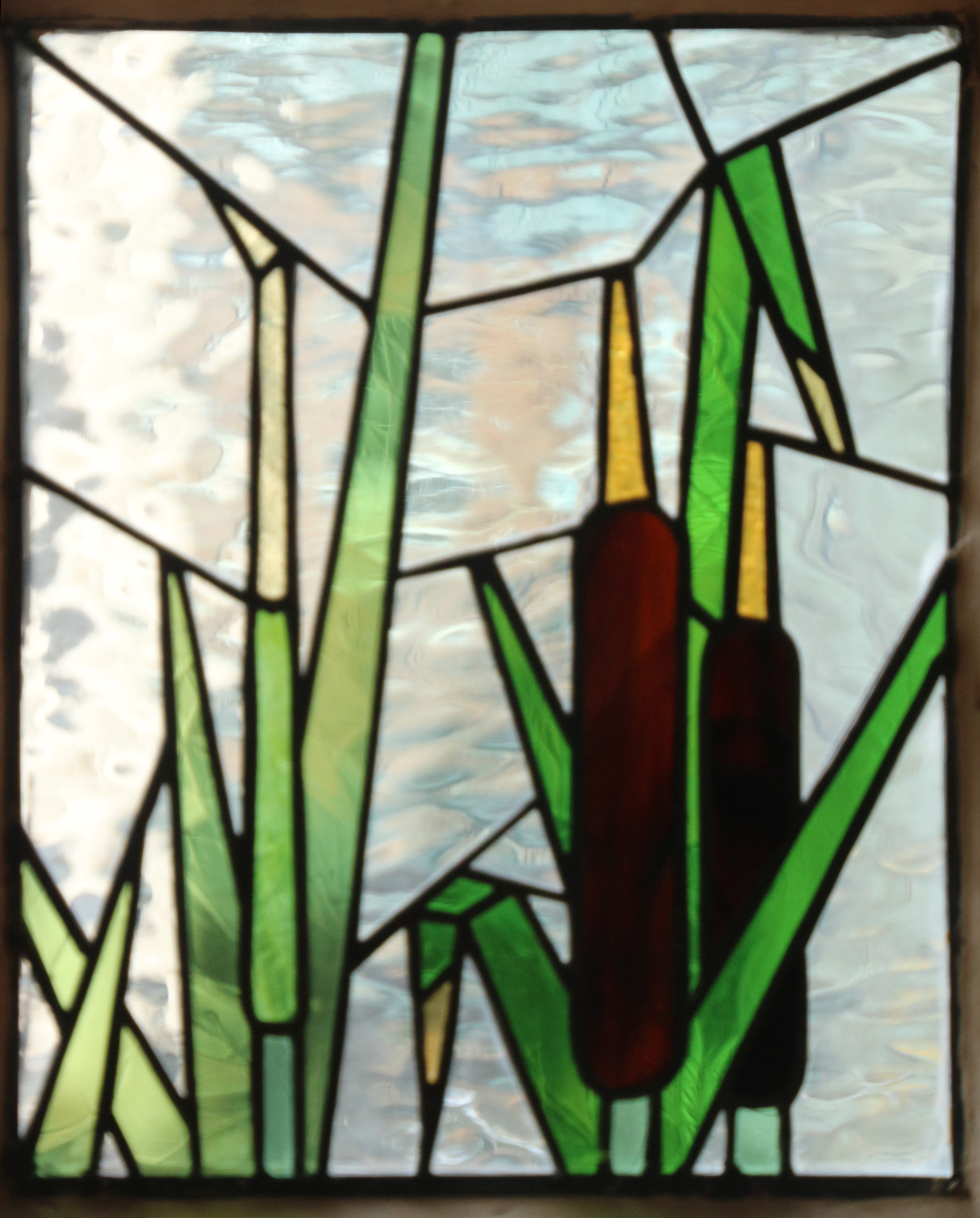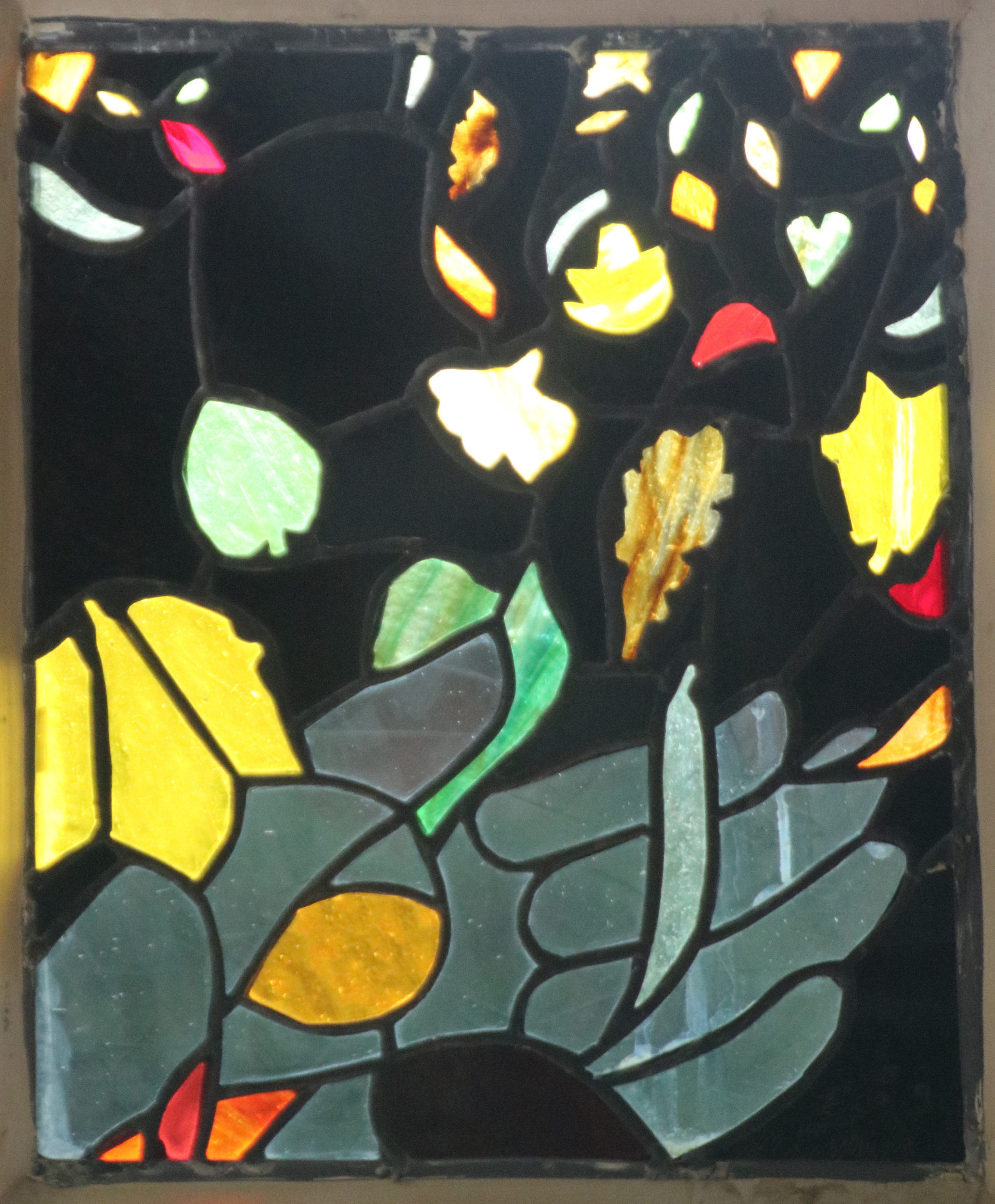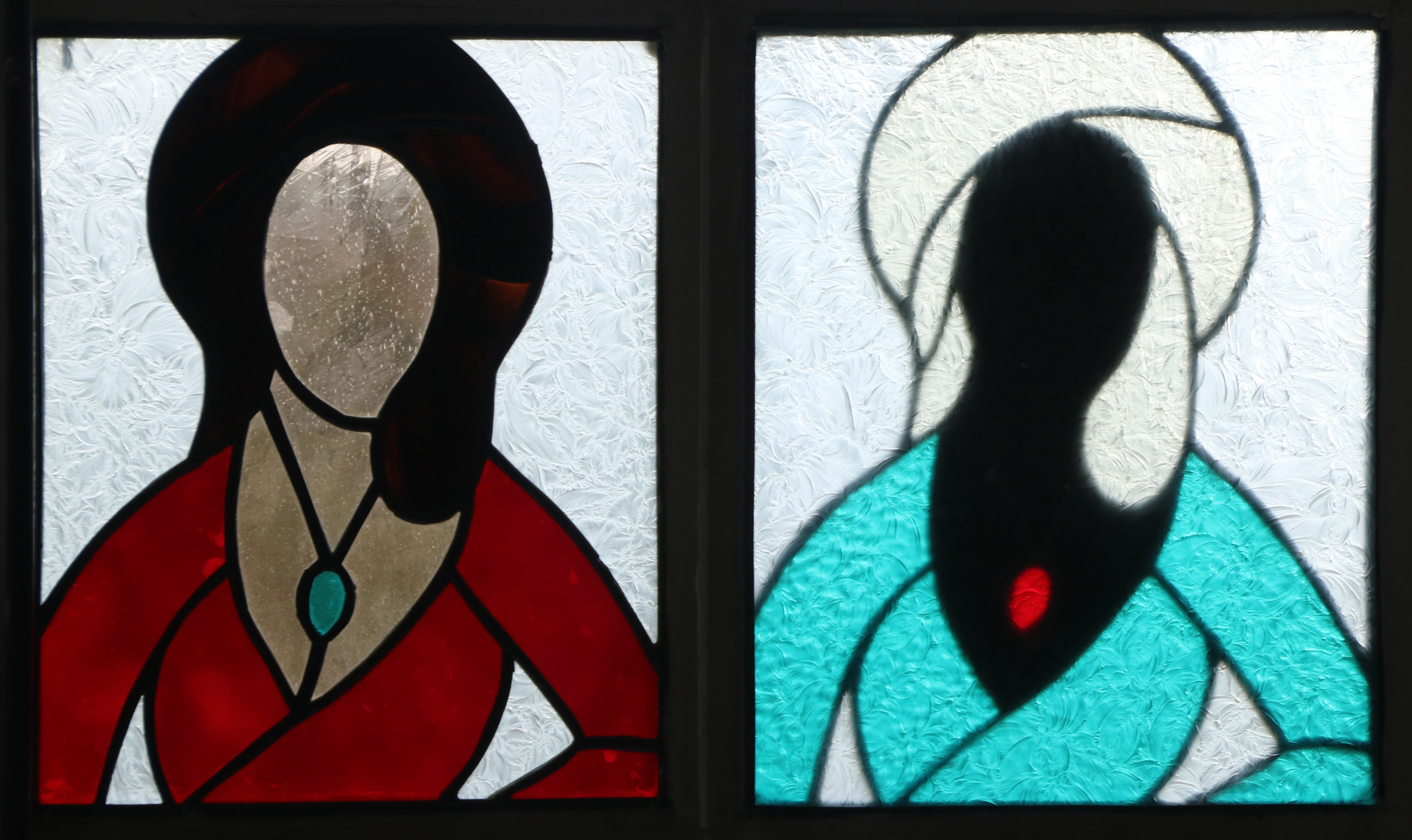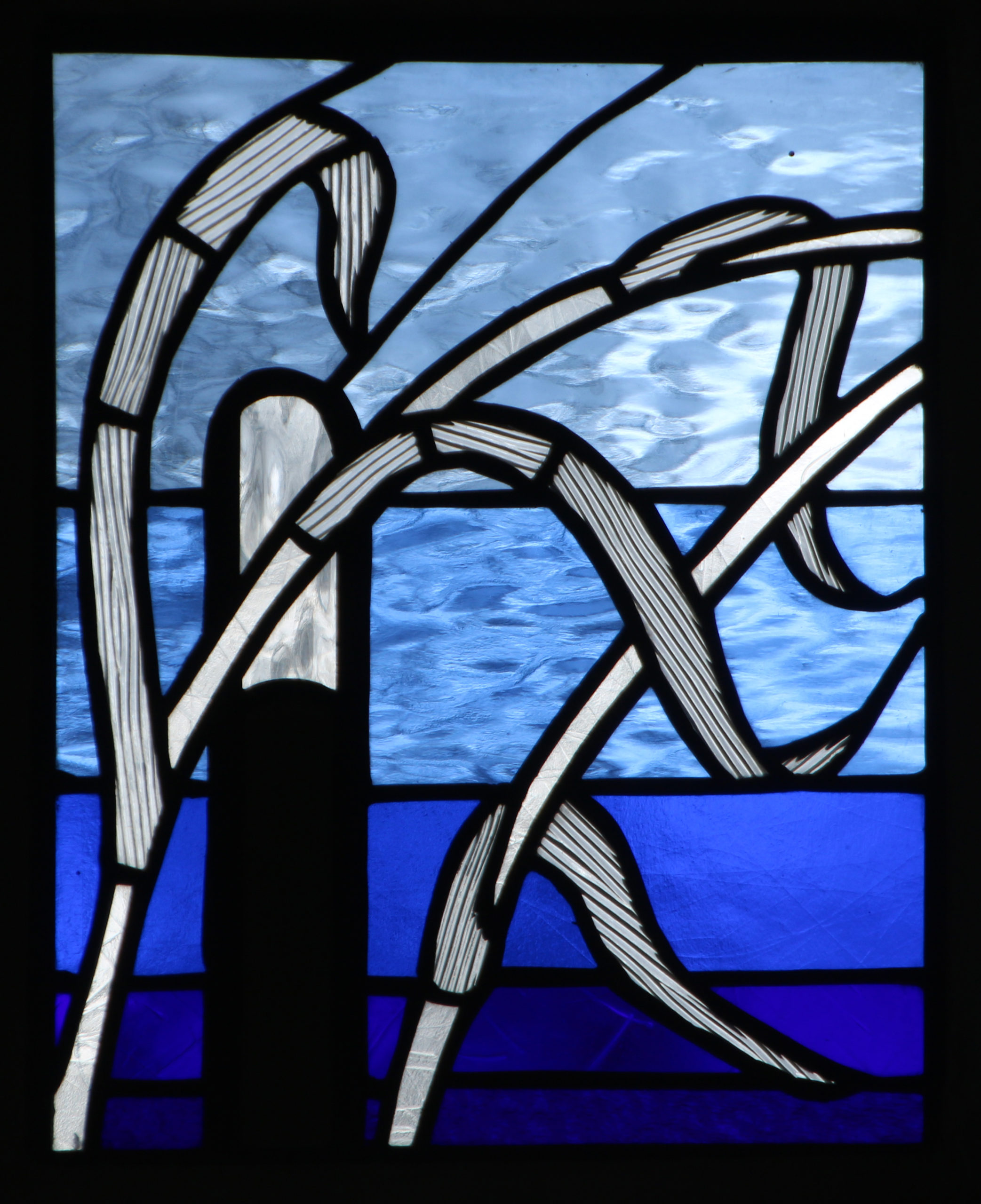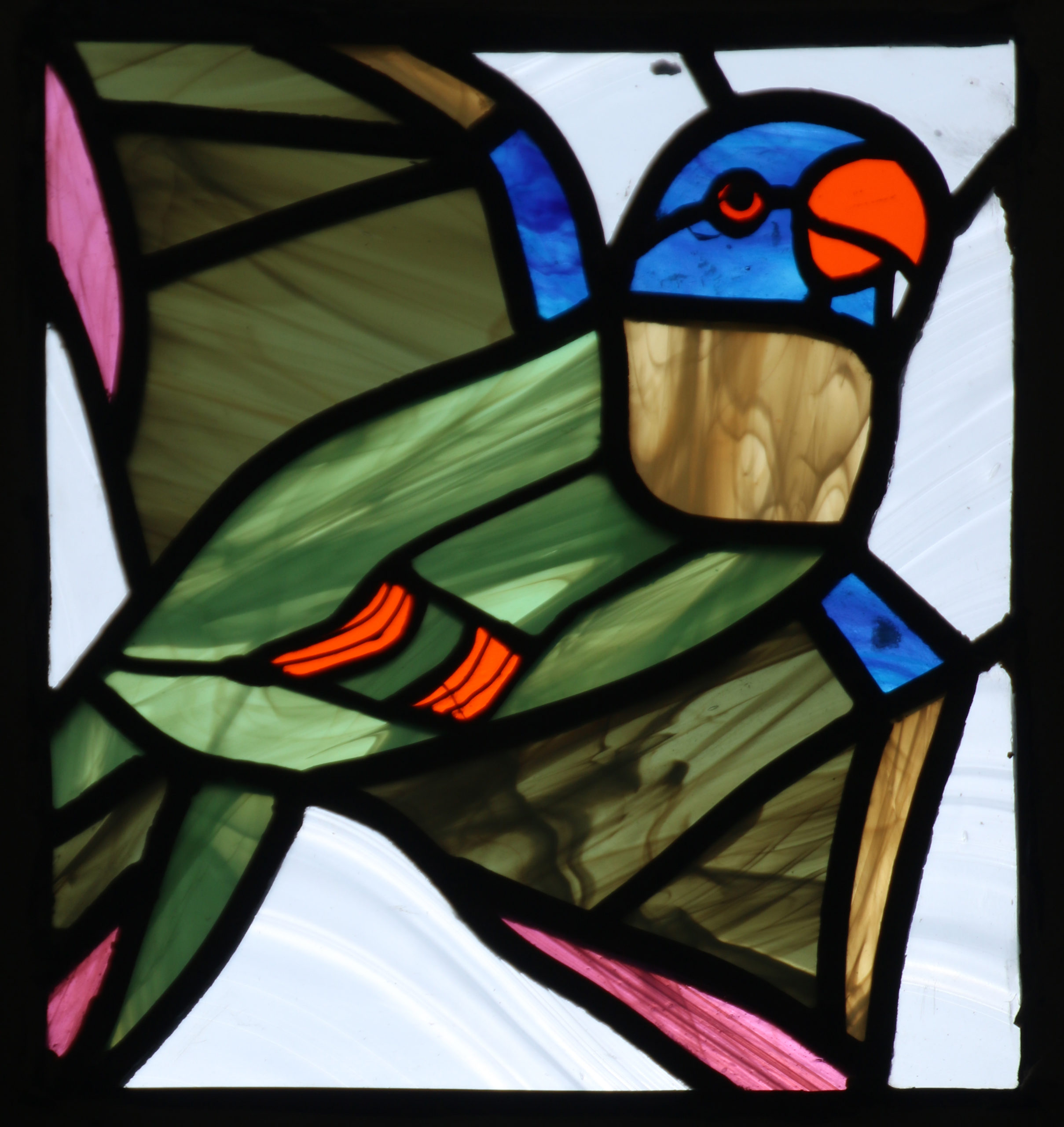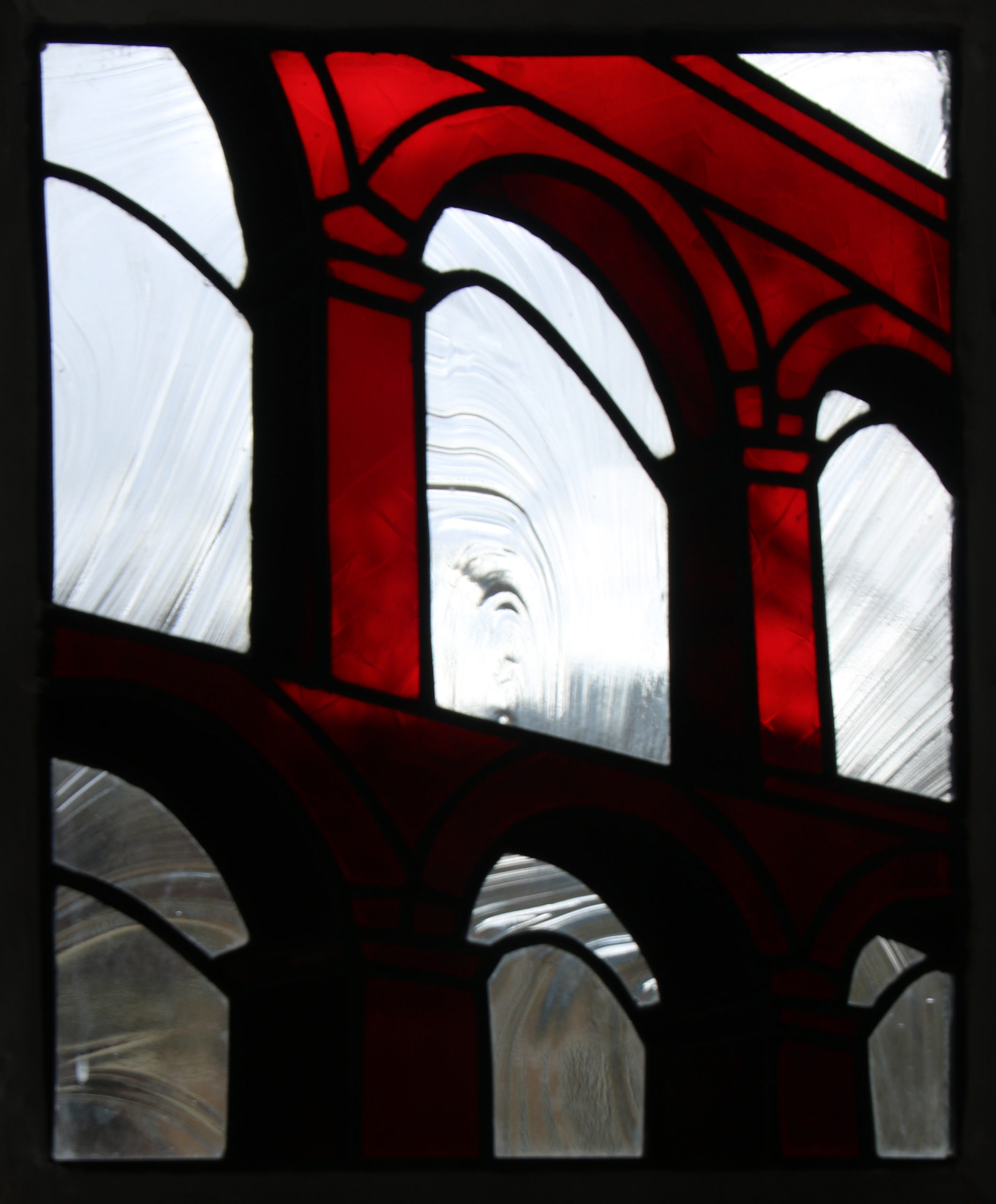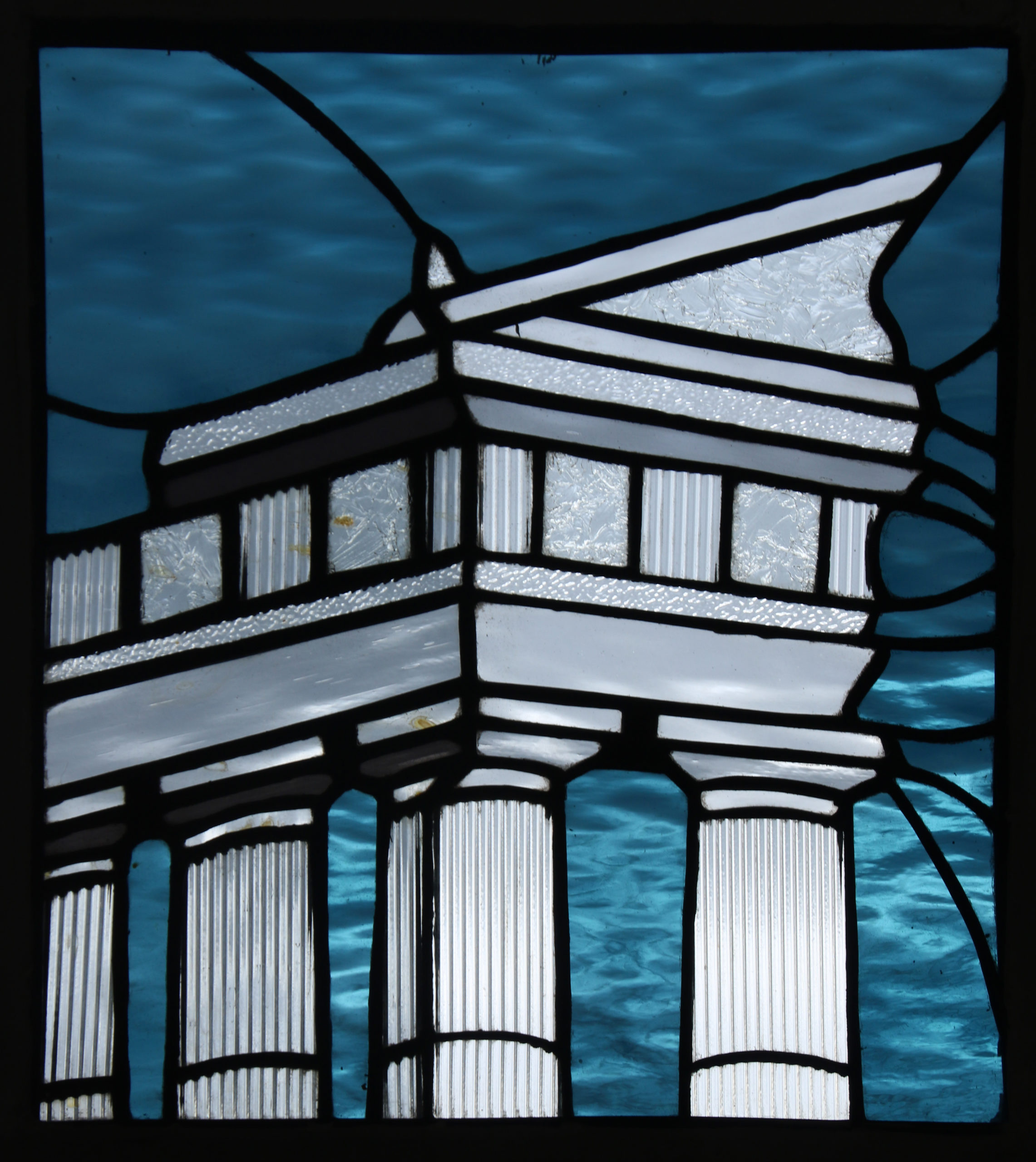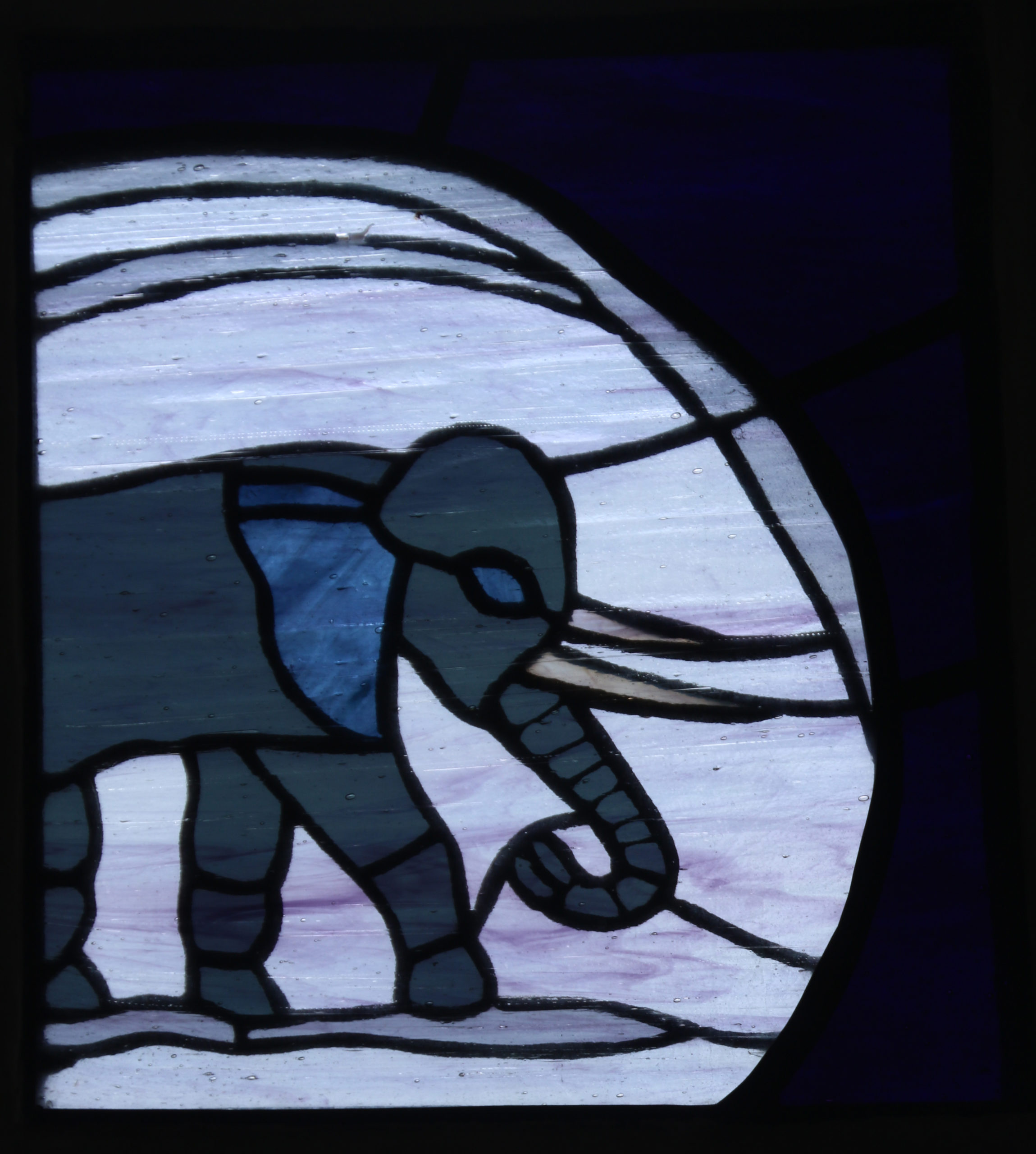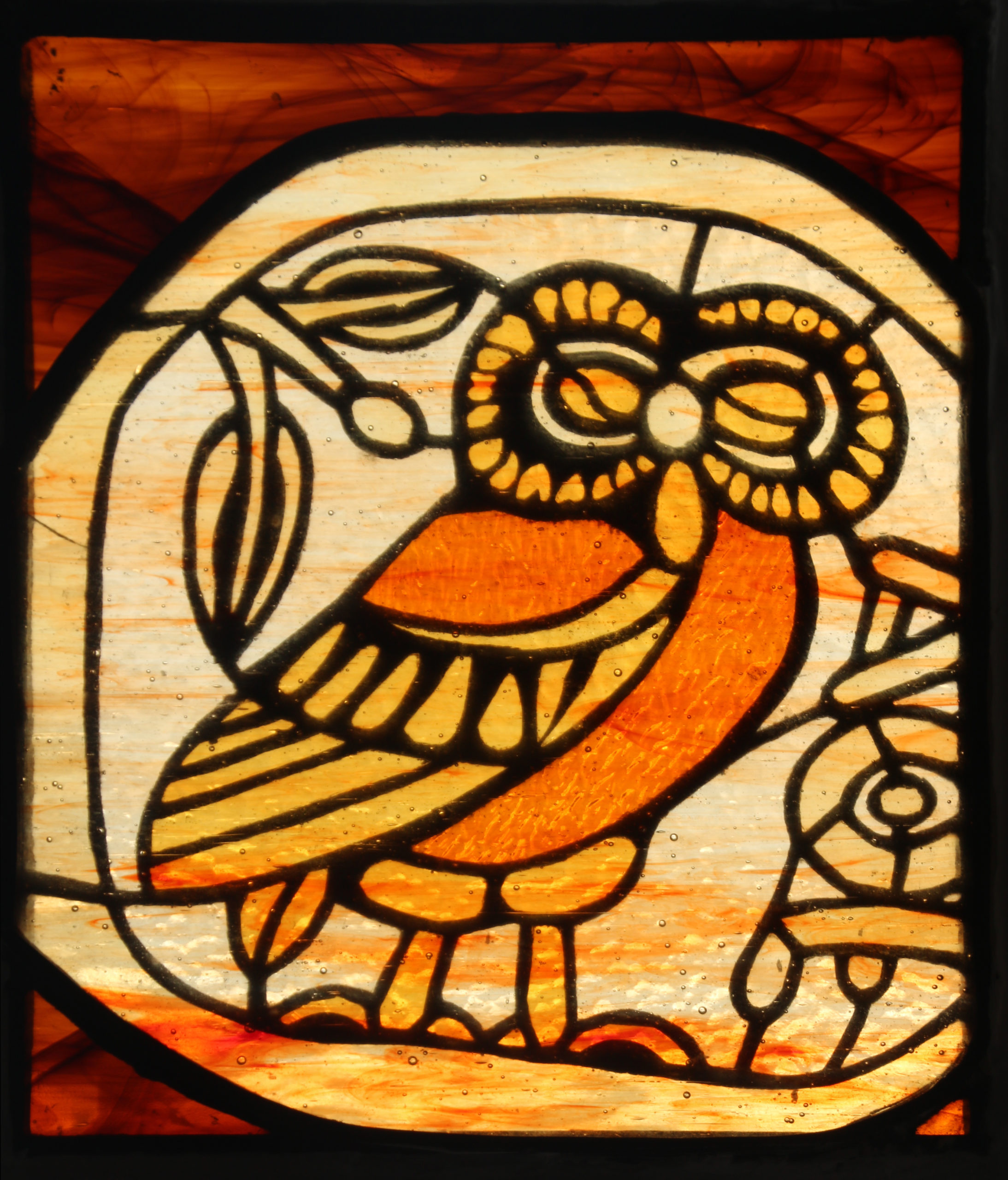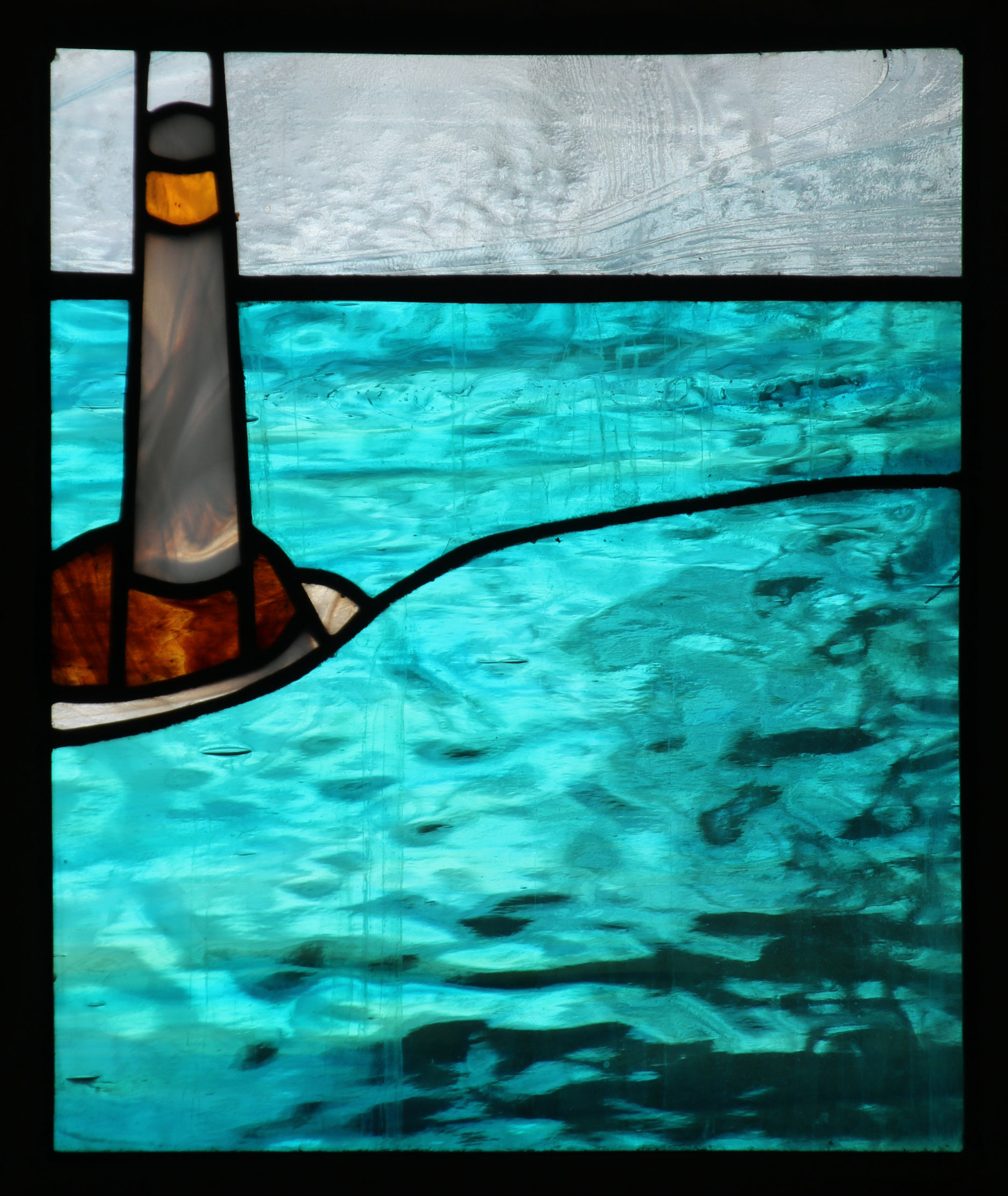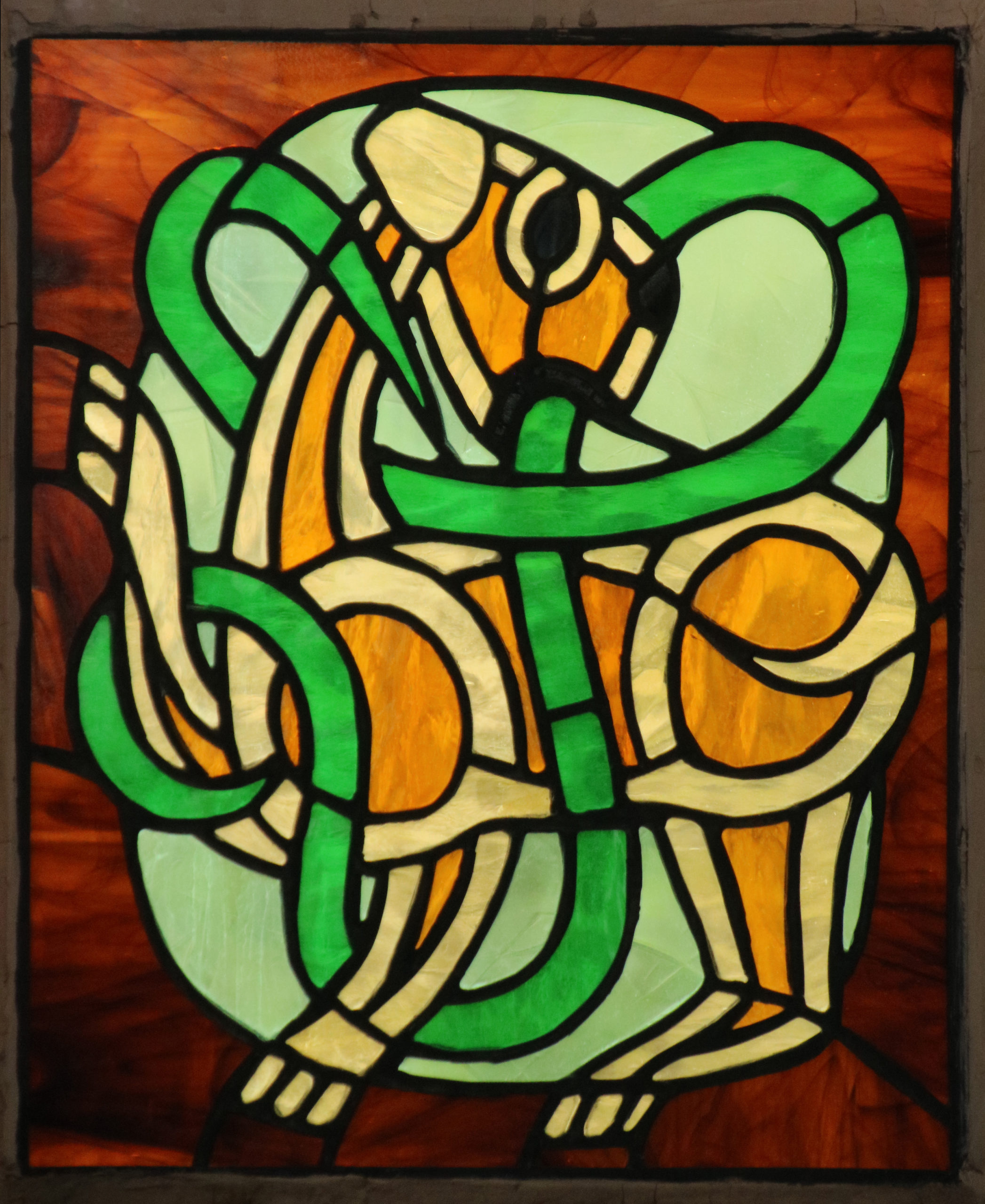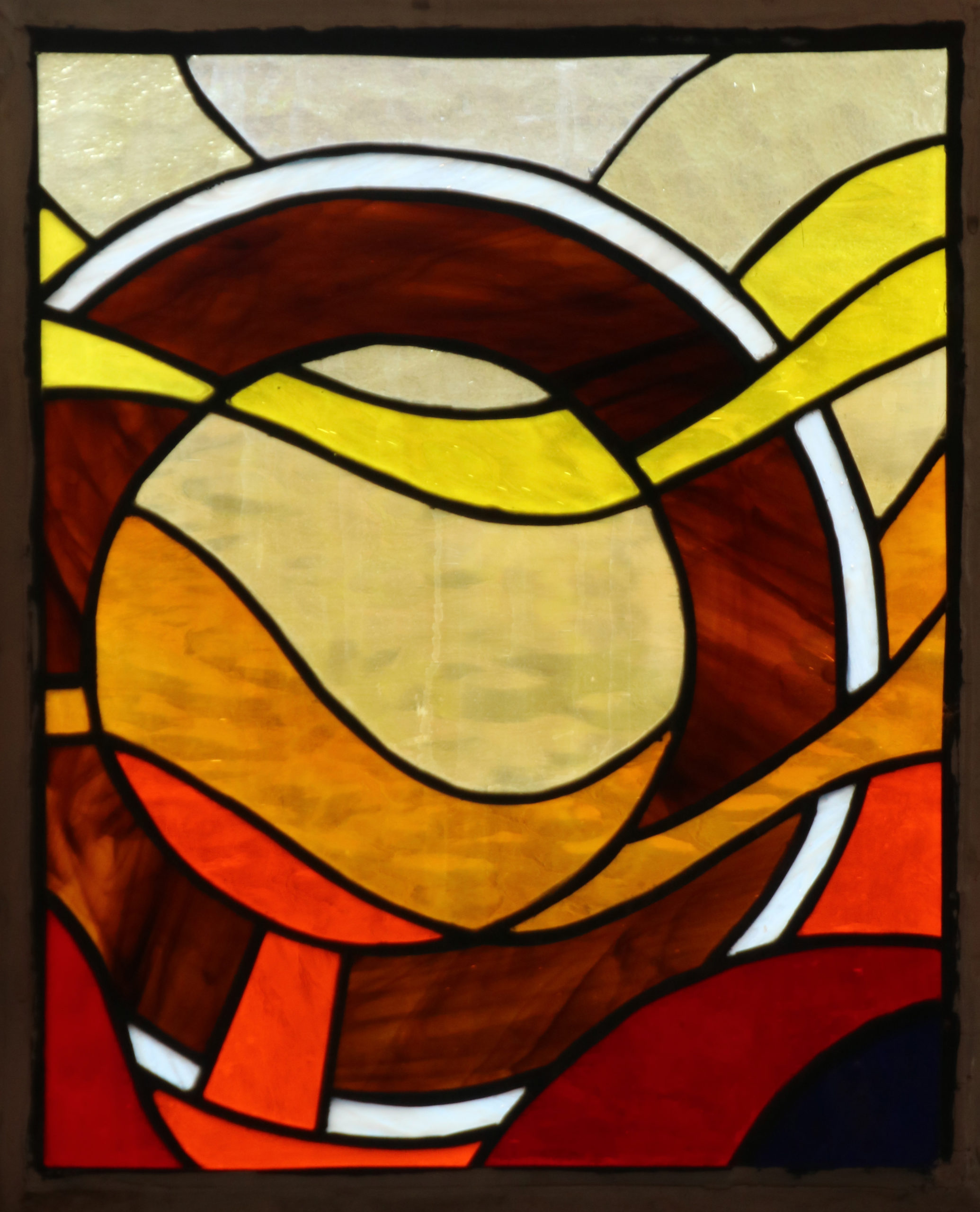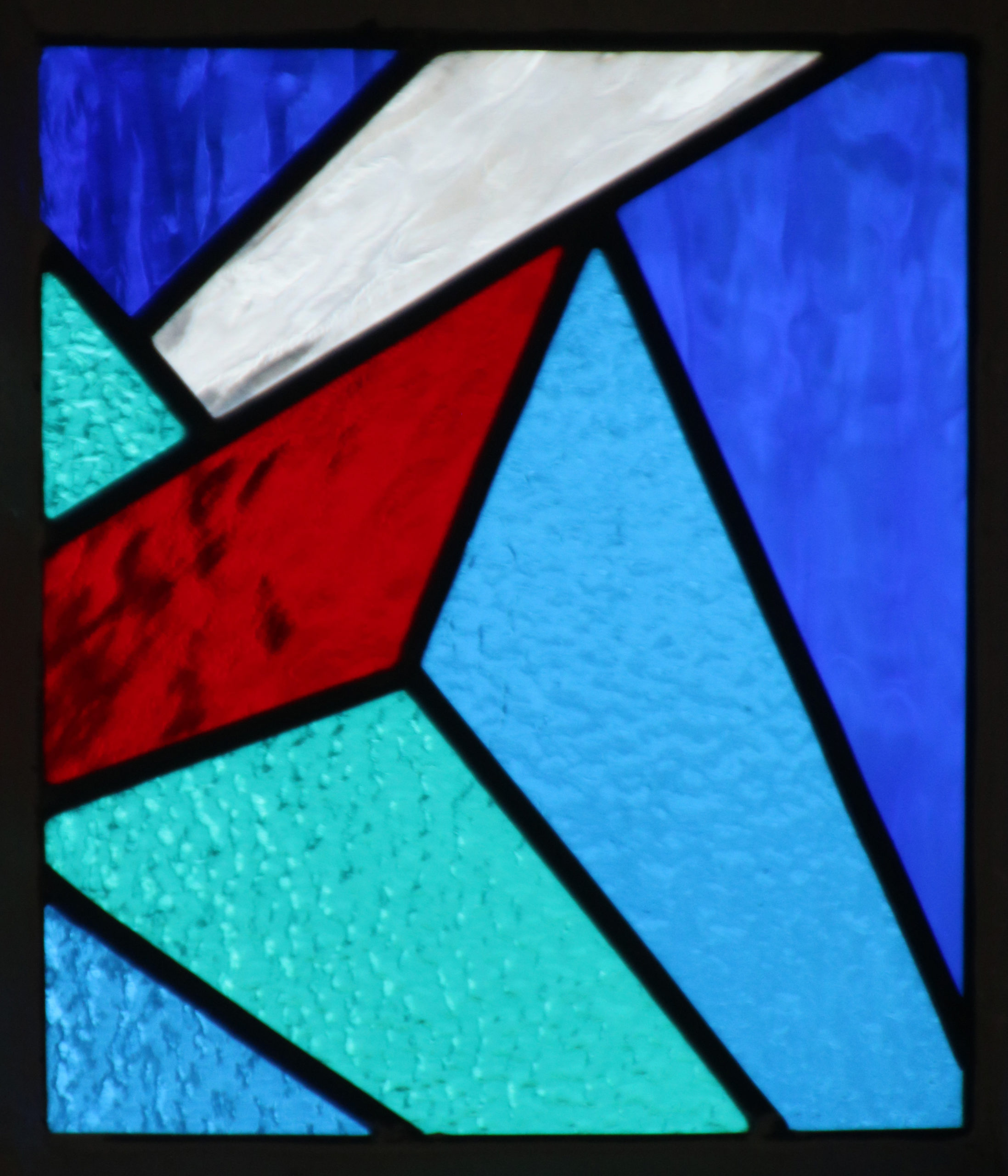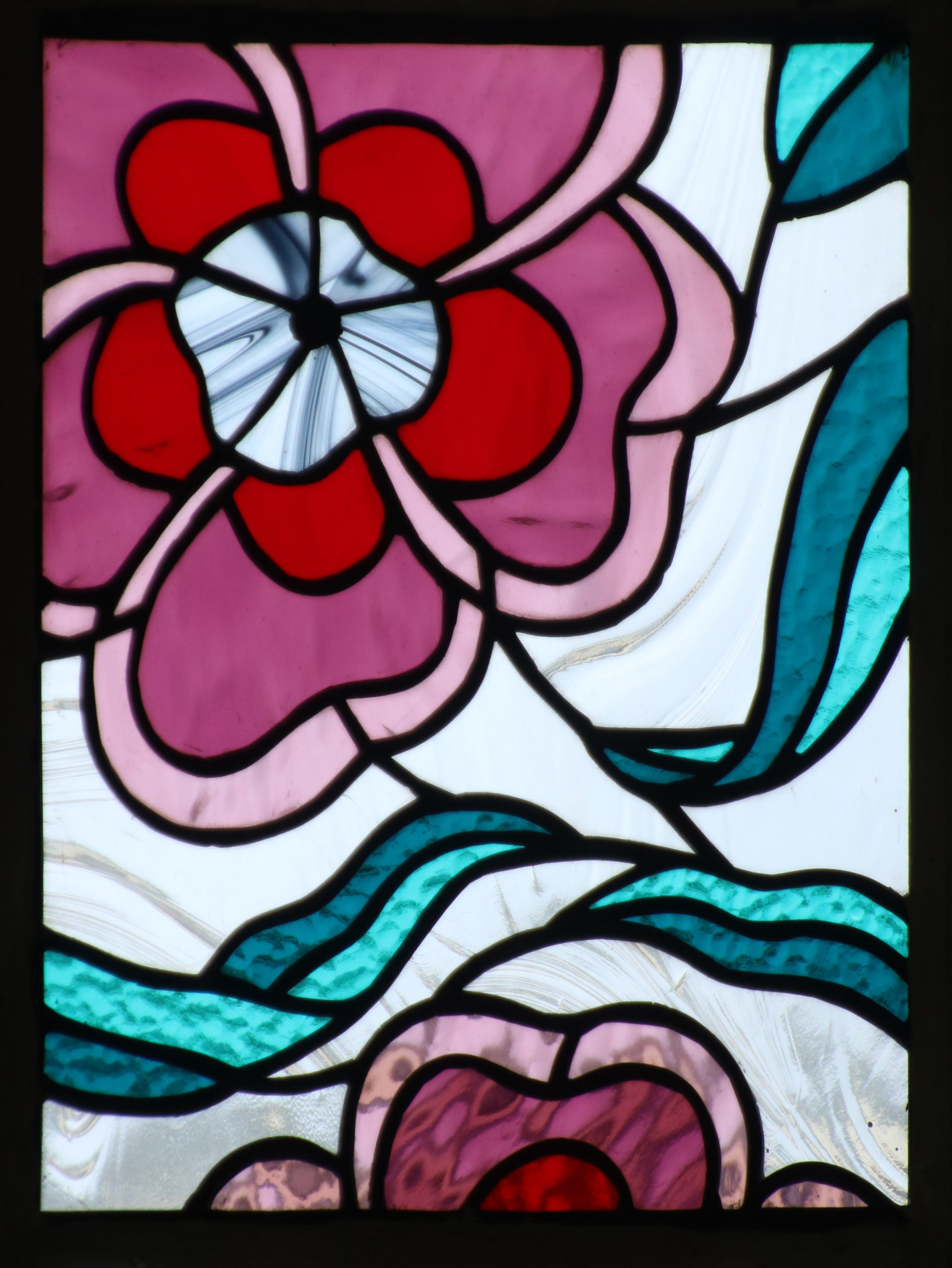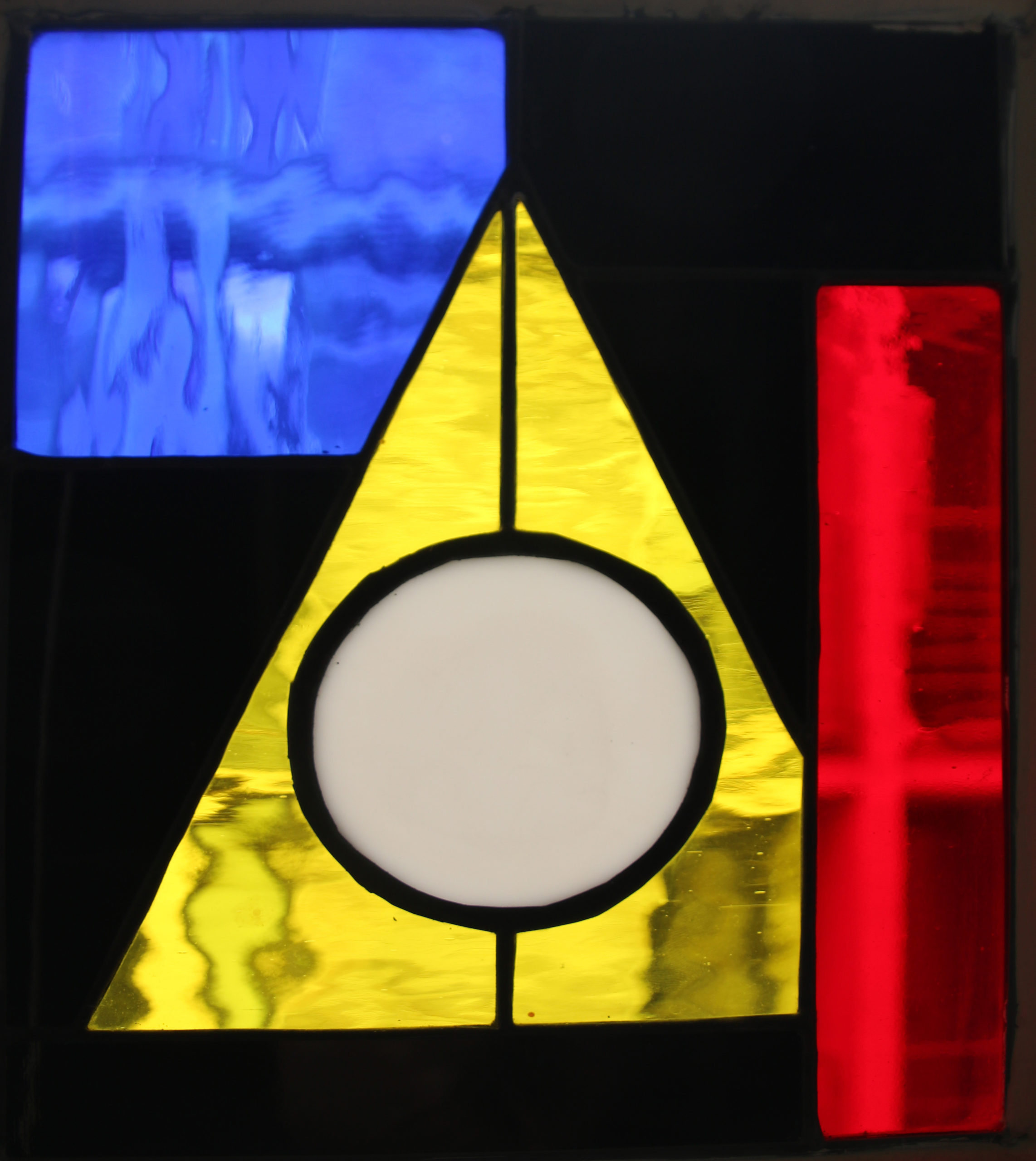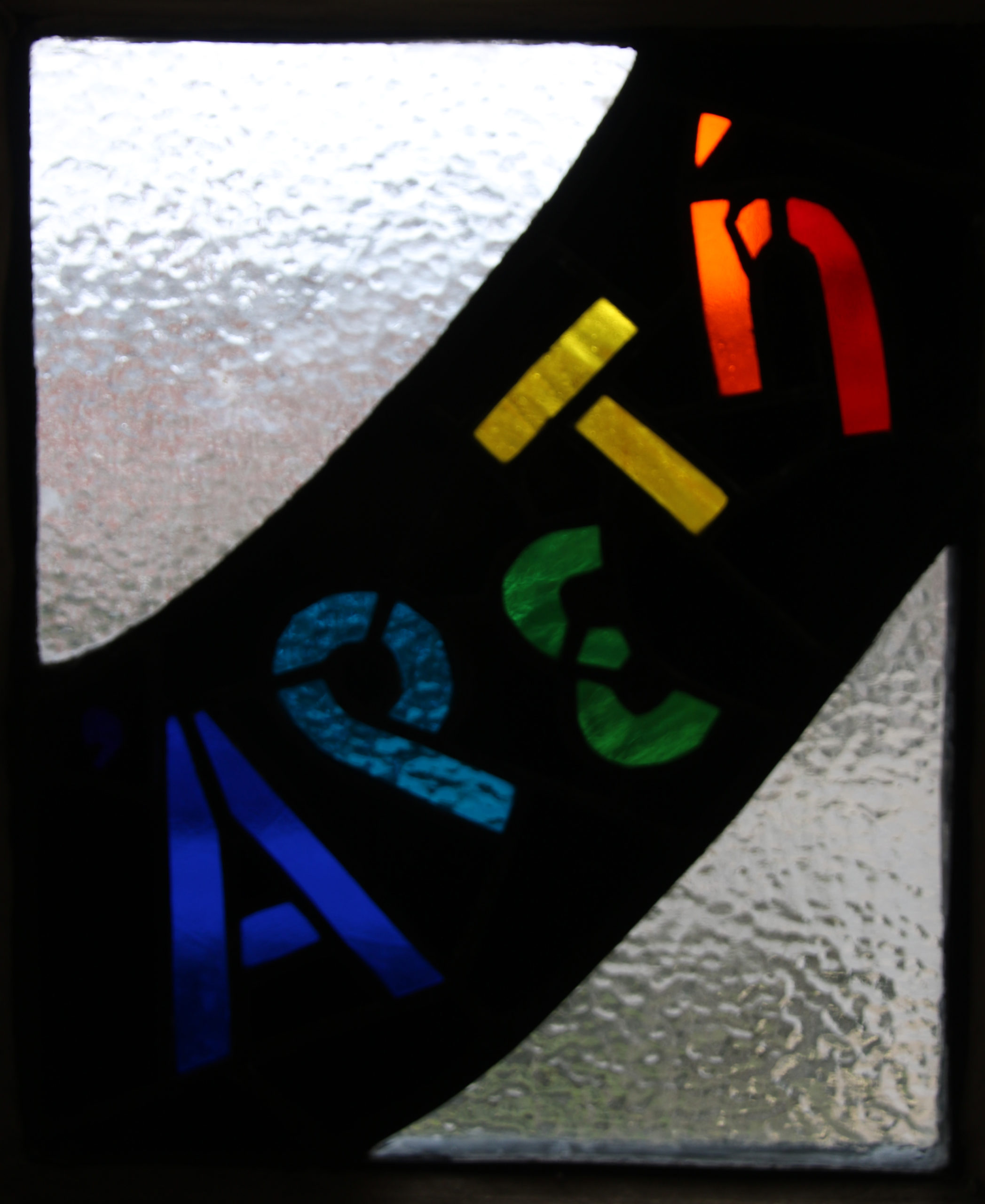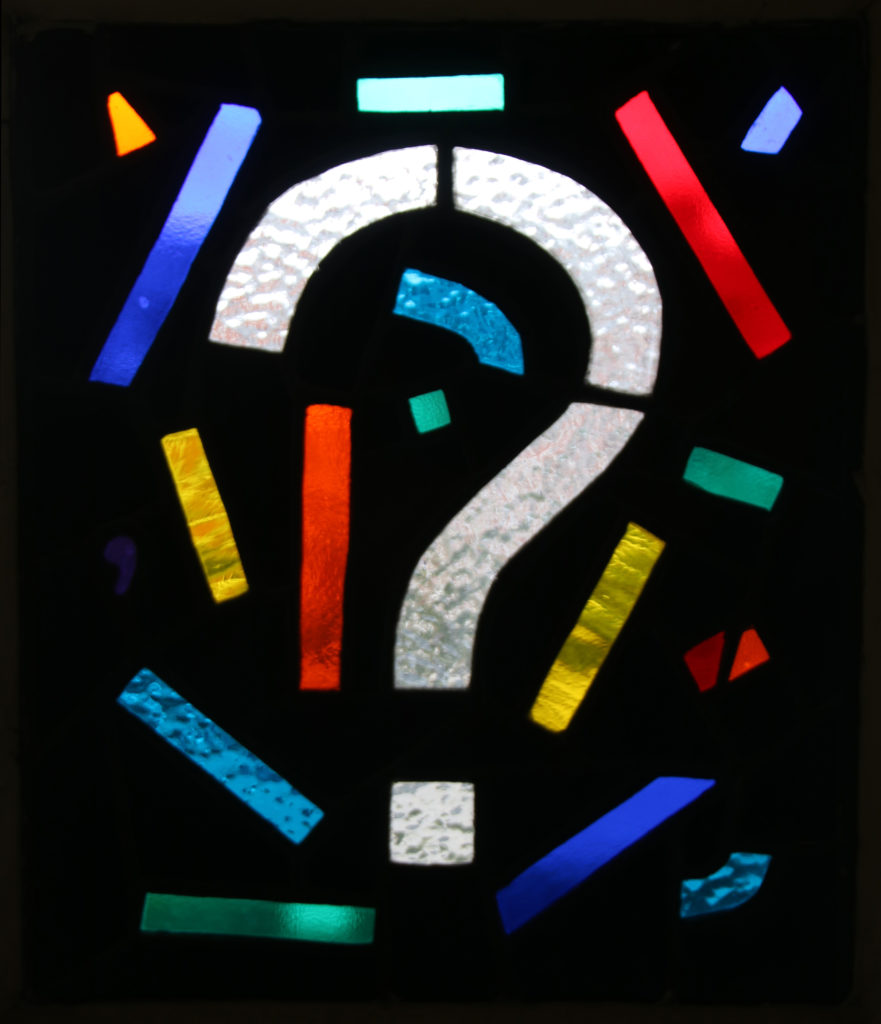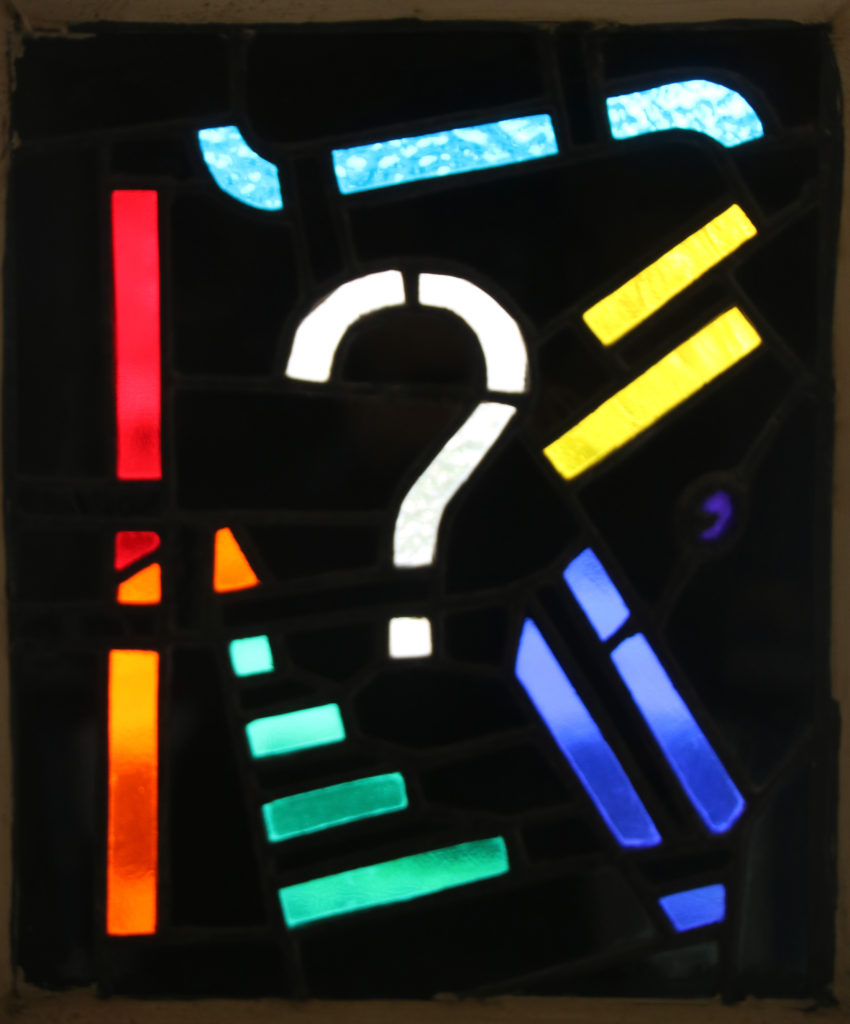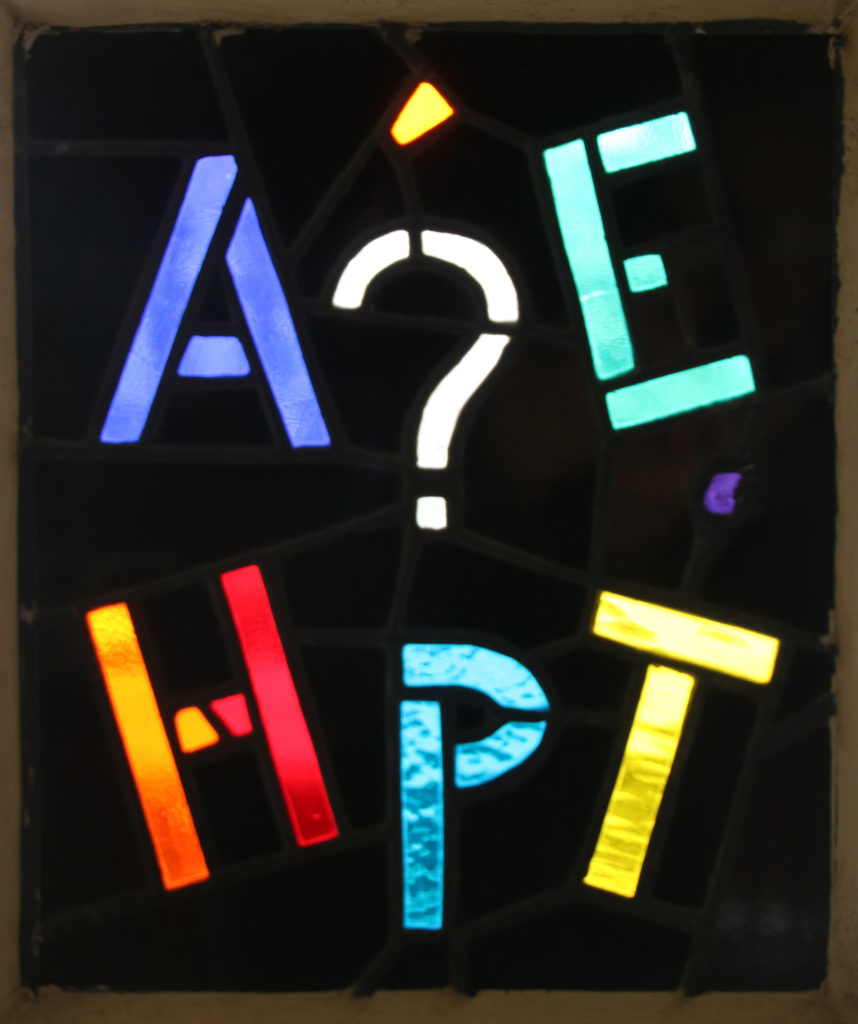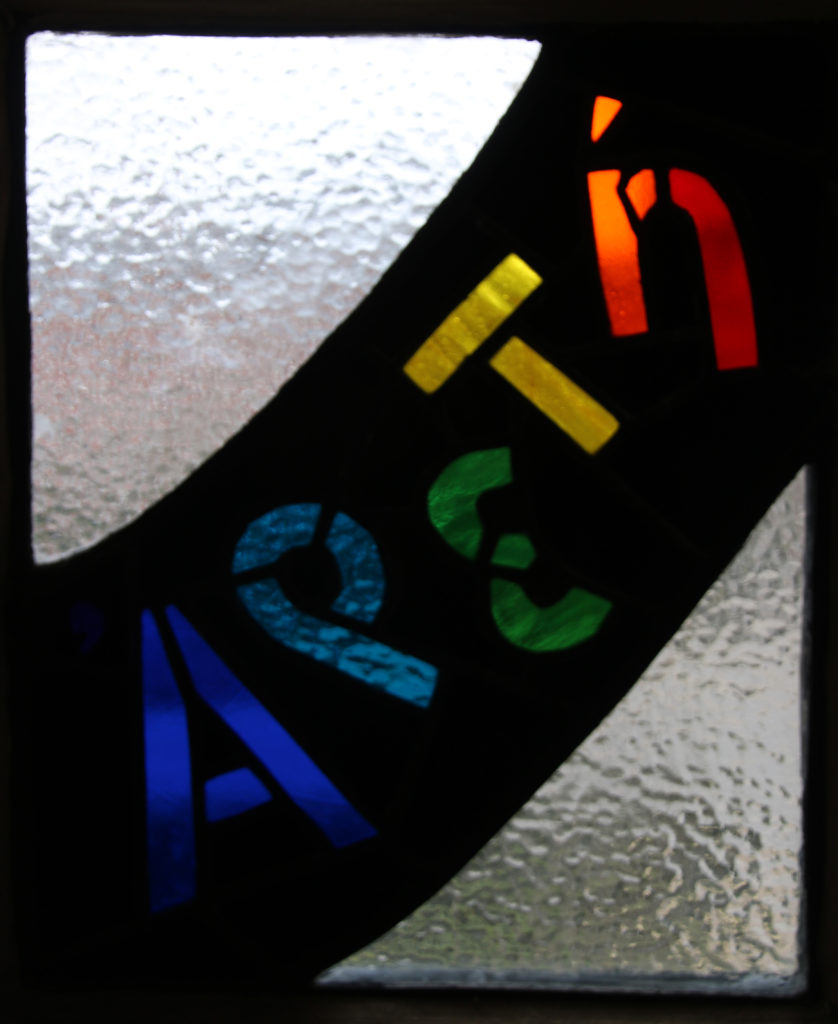Welcome to this online exhibition of the stained-glass windows in Hartland House.
The windows were designed and made by Hazel Rossotti from 1997-2014. You can read more about the artist and the background to design and making of the windows on our Library blog:
College Members can also use this page as a guide while viewing the windows in Hartland House and the terms “left” and “right” are used on this assumption that the viewer is inside the Library. Entrance to the Library on the ground floor is from the East, windows overlooking the Willow Quad (Dining Hall side) face South, windows facing the front of College and Woodstock Road are West, and the Ruth Deech Building is to the North.
Ground Floor, Entrance
The Trinity
Based on a figura in MS 255A Corpus Christi College, the Liber Figurarum of the Calabrian Abbott, Joachim of Fiore (c.1135-1202). The Three Persons of the Trinity are represented in green (the Father), blue (the Son) and red (the Holy Spirit). The Unity of the Godhead is symbolised in the central segment common to all three circles.
The panel celebrates the award of a CBE to Dr. Marjorie Reeves, a Founding Fellow of the College, who did much research on Abbott Joachim and wrote the notes above.
This representation of overlap is an early example of a Logic Diagram, widely used by Ramon Llull (d. c. 1315), and developed by Gottfried Leibniz, Leonhard Euler and (from 1880) by John Venn, by whose name such diagrams are now generally known.
Mouse
Charter
This panel depicts the year in which St Anne’s was granted collegiate status as an LED display and was designed in conjunction with Dr. David Smith (Librarian).
In 1952, St Anne’s Society, as the College was then known, received its royal charter and officially became St Anne’s College.
The College needed a coat of arms and was given permission by the Principal, Eleanor Plumer to use her family’s crest, which also appears on a later window in the Academic Communities series.
Ground Floor, Fulford Room
Unofficial emblems of the college. These two panels celebrate the publication in 2011 of the hundredth edition of “The Ship”, the annual magazine of the Association of Senior Members.
Beaver Tracks
The Society of Home-Students adopted the beaver as a crest in 1913. Ruth Butler (Vice-Principal) felt it was an appropriate mascot as “The Beaver lives in communities: he even, we are told, undertakes work of a communal character; but he returns to sleep in his own little “lodge”, remaining at heart a Home-Student.”
Beavers’ tracks are seldom as clear as they are show in the panel, because the hind paw usually covers much of the impression made by the fore paw, and often completely obscures it.
Ship
“Sail on, O Ship —
Sail on, O union, strong and great”
These lines from ‘The Building of the Ship’ by Henry Wadsworth Longfellow (1807-1882) used to appear annually in The Ship, the publication of the Association of Senior Members, and were adopted as a motif by the Society of Home-Students.
The Society, through its Principal, Bertha Johnson, acquired a building on Ship Street in 1910, which provided it with a first home of its own, including a Common Room. It is usually assumed that the connection with the ship as an emblem comes from this time.
The ship in this panel is adapted from the weather vane on top of the Dining Hall. It was designed by the architect (Gerald Banks, 1961), who in turn based it on the ship in the coat of arms of the City of Paris.
Memorial to Jim Stanfield
The initials JJS on the north wall commemorate Jim Stanfield (Chemistry, 1979) who died in 2012 whilst President of our Association of Senior Members. With appropriate lighting, they can be read from either side. The colours are the optical primaries; mixtures of light from these three sources can provide almost all the visible spectrum
Ground Floor, New Reading Room
Mould
Symbolises fungal mycelium and fruiting bodies.
The New Reading Room, in which this panel sits, is also called the Cephalosporin Fund Reading Room, having been funded by the E. P. Abrahams Trust. Professor Sir Edward Abrahams (1913-1999), whose work on a fungus found in Sardinian sewage led to the manufacture of the antibiotic Cephalosporin, approved the design, but was never able to see the panel in situ. Installed in 1997, it was the first stained glass panel in the Library, and was made in appreciation of his gift.
Grateful thanks to Mary Archer (née Weeden) for her most generous gift to College
Dame Mary Archer, alumna of the College, known for her work in solar energy
River, the Cam, flowing north.
Top right (running to top L and bottom R) the sun, with beams and electric cell, celebrating her book on Photo-Voltametry.
Left, parts of College scarves in Mary’s times (scholar of St. Anne’s and Fellow of Newnham).
Left central Mary’s interests as a Fresher, the quaver for choral work, her average marks on the entrance exam, and c for cats.
Right central; A for Archer her surname since July 1966 and for Addenbrooke’s Hospital of which she was Chairman for 10 years. G is for Grantchester, where Mary and Jeffrey bought the Old Vicarage, where Rupert Brooke had digs and wrote his poem about it. Mary wrote a book on this, too. G also represents the church there, where Mary was Choirmistress for 15 years.
Lab
A chemistry lab, contemporary with the Library (completed in 1937). Chemists of that period would have detected hexa-aquocobalt(II), tetrachlorocobalt(II), hexanitritocobalt(II), malachite, and hexa-aquocopper(II), together with products formed by its reaction with ammonia and potassium iodide (although they would not have used this nomenclature).
Flames
The shapes of the flames in this panel represent the initials S and A to commemorate two of Hazel’s former pupils who died whilst at St Anne’s:
Su Holmes (Biochemistry & Physiology) died 1973 and Anton Tchetvertakov (Chemistry) died 12 February 1999.
The yellow (diffusion) flame is from a candle, and the blue (pre-mixed) flame is from a Bunsen burner.
Fractal
Concepts
A series of panels relating to concepts in Philosophy, Theology, and Maths. The use of different intensities of a single colour in this series was inspired by the windows in the 12th-Century Cistercian Abbey at Le Thoronet, Provence, France. These are mostly in pale shades of amber, with a few in subdued pink and were installed during the restoration of the abbey in 1935. The original building had no coloured glass, but the additions are said to be an exact copy of those in the contemporary Cistercian abbey at Obazine, near Corrèze, Limousin, France.
Logos (mauve): Λ and W (Greek λόγος and Teutonic Word)
Monotheism (amber): Symbols of the related religions Judaism (star), Christianity (cross) and Islam (crescent)
Maths (turquoise): The symbols x (Arabic), 0 (Hindu) and π (Greek)
Psi (blue): (i) The wave function of an electron, and/or (ii) the human psyche
Alpha and Omega (green): The Beginning and the End (from the Greek alphabet)
Yin-Yang (plum): Complementary human qualities e.g. gentleness and strength (Chinese).
Stairs
Partial heraldic devices for communities of which we are part.
Academic Communities
St. Anne’s College
These panels show a lion’s head, three ravens, and the sword and laurel wreath from the College’s coat of arms. The coat of arms and motto – Consulto et Audacter (Purposefully and Boldly) – were adpoted from the family crest of Eleanor Plumer, Principal when the College received its Royal Charter.
Blazon: Gules, on a chevron between in chief two lions’ heads erased Argent, in base a sword Argent with pommel and hilt Or and enfiled with a wreath of laurel proper, three ravens Sable.
University of Oxford
The crest of the University features three golden crowns, an open book, common in the heraldry of educational institutions, with an inscription of the motto Dominus illuminatio me (The Lord is my light) from Psalm 27.
Blazon: Azure, upon a book open proper leathered Gules garnished or having on the dexter side seven seals of the last the words DOMINVS ILLVMINATIO MEA all between three open crowns two and one Or.
Non-Academic Communities
United Kingdom
The Union Jack combines the saltires of St. Andrew and St. Patrick, for Scotland and Northern Ireland, and the cross of St. George for England (also represented in its own panel).
The United Nations
A projection of the globe and olive branches, symbols of peace.
European Community
12 gold stars in a circle on a blue background, symbolising the ideals of unity, solidarity and harmony among the peoples of Europe, not the 12 funding member-states of the European Union, as commonly believed.
The City of Oxford
An ox crossing (or fording) a river, presumably the Thames. This form of the coat of arms was supplied by the then Lord Mayor, Mrs. Maureen Christian.
First Floor, Geldart Room
Embryo
Celebrates the award of DBE in 2002 to the then Principal, Ruth Deech, at the end of her chairmanship of the Human Fertility and Embryology Authority. The design is taken from the Authority’s letterhead, and incorporates its etched initials. Baroness Deech chose the colours, and approved the design.
First Floor Corridor, North-Facing Windows
Some simple geometrical shapes in nature
Snowflakes
C60
Part of the football-shaped molecule of buckminsterfullerene (“buckyballs”), C60. As in many footballs, the molecule is made up from pentagons and hexagons.
Designed from a postage stamp celebrating the award of the Nobel Prize in 1996 to Sir Harry Kroto for his work on this new form of carbon, which is the basis of nanotechnology.
Rings of Saturn
Starfish
Lily pads
Bulrushes
First Floor Corridor, South-Facing Rooms
Foreign languages and culture
Modern Languages 1
Aspects of German Literature
Rilke
An attempt to interpret the poem Herbst (Autumn) by the Austrian poet Rainer Maria Rilke (1875-1926).
“Die Blätter fallen, fallen wie von weit,
als welkten in den Himmeln ferne Garten;
sie fallen mit verneinender Gebarde.”
“The leaves fall, fall as from far,
Like distant gardens withered in the heavens;
They fall with slow and lingering descent.”
The full poem can be found in the Library on p. 54 of Das Buch der Bilder (shelfmark 832.6 RIL:Buc).
Goethe
These twin panels depict the phenomenon of afterimage, as described by Johann Wolfgang von Goethe (1749-1832) in his Theory of colours (1810).
Even the glass panel can generate such an afterimage. (Try it).
“I had entered an inn towards evening, and, as a well-favoured girl, with a brilliantly fair complexion, black hair, and a scarlet bodice, came into the room, I looked at her attentively as she stood before me at some distance in half shadow. As she presently afterwards turned away, I saw on the white wall which was now before me, a black face surrounded with a bright light, while the dress of the perfectly distinct figure appeared of a beautiful sea-green.” Para. 52
It was a happy coincidence that Goethe studies were a speciality of Dr, David Smith, Librarian at the time the panel was installed.
Modern Languages 2
Aspects of French Literature
Pascal
“Man is but a reed………… but a thinking reed”
Blaise Pascal, Pensées, No. 347 (published 1669, seven years after his death).
The work of the French Mathematician and Physicist, Blaise Pascal (1632-1662), was a speciality of Dr. Annie Barnes, a Founding Fellow of the College, whose portrait hangs nearby. The barometer rising improbably from the reed-bed symbolises Pascal’s interest in air pressure. He was the first person to show that the space above the mercury was a vacuum. The modern SI unit of pressure is named after him; standard atmospheric pressure at sea level is 101.315 pascals.
Flaubert
Parrot from Un Coeur Simple, a short story by the French novelist Gustave Flaubert (1821-1880), first published in his Trois contes, 1877. As far as possible, the colours follow the text, rather than ornithological reality:
“Il s’appelait Loulou. Son corps etait vert, le bout de ses ailes rose, son front bleu, et sa gorge dorée.”
“He was called Loulou. His body was green, his head blue, the tips of his wings were pink and his breast was golden.”
The full story can be read in Trois contes (shelfmark 842.5 FLA:Tro ed. SAC).
Classics Room
Classical architecture in the provinces and ancient coins
Aqueduct
Temple
Greek temple at Agrigento, Sicily. Designed from the print which hung nearby.
This panel depicts a partial reconstruction of the remains of Tempio dei Dioscuri, a Greek temple in the Valley of the Temples at Agrigento, Sicily. Dedicated to Castor and Pollux, half-twins in Greek and Roman mythology who make up the constellation Gemini. Coincidentally, castor is the Latin for beaver, the mascot of St Anne’s.
Elephant
A silver Carthaginian shekel.
The elephant, which appears on the reverse of some Carthaginian (or Punic) coins, was suggested by Professor Matthew Leigh (Fellow in Classics). Designed after an image (1996.161951) from the Museum of Fine Arts, Boston, which was sent to Hazel by Anne Gibson (Classics student, 1979), who had discussed the topic with her on a chance meeting on holiday in Greece.
Owl
An Athenian gold coin, designed from a replica.
The owl is associated with the Athena, Greek goddess of (among other things) wisdom, and was common on the reverse of Athenian coinage.
Dr. Henry Kim of the Ashmolean confirmed that coins of this type had often been minted in gold, although most of them were later melted down.
First Floor, Main Reading Room
Aspects of English Literature
Lighthouse
Zoomorph
A reminder of the Nordic origin of the English language, which was taught in St. Anne’s by Elaine Griffiths, a Founding Fellow of the College. The panel is housed near to her portrait in the reading room.
Zoomorphism relates to the depiction of humans or non-animal entities and objects in animal form. This, along with intertwining elements, is a common feature of Viking art and imagery.
Globe Theatre
Celebrates playwright and poet William Shakespeare (1564-1616), one of the most influential figures in the history of English Literature. The range of colours suggests the broad emotional spread of Shakespearean drama. The globe figure is for his Globe Theatre in London. Shakespeare’s Globe, a modern-day reconstruction near to the original theatre’s location, had recently opened when Hazel starting making these windows.
Abstract & Flowers
Classical and Romantic aspects of literature
These two panels were designed by members of Library staff, with free choice of subject, but are used here as symbols of the classical and romantic aspects of literature. Abstract, by Julia Chadwick (Library Assistant), needed no modification and Flowers, by Emma Sherratt (Library Assistant) needed only some adaptation to the medium of glass.
First Floor, North Room
Shapes
Taken from a design requiring these four geometrical forms for a compulsory project for a CFE assessment (which never took place); and adapted in response to a request to cheer up the North Room. The theme was then extended to include simple geometry in natural objects, the series on the windows of the First Floor Corridor.
Intellectual Progress
Four panels representing Intellectual Progress:
(1) Beginners’ panic ;
(2) Looks more structured with colours collected ;
(3) The coloured pieces make Latin capitals, but what of the accent or the apostrophe? “Oh, —, it’s all Greek to me” ;
(4) Eureka. It is.
Put the letters in rainbow order with the highest energy (lowest wavelength) first and then make all except the first lower case. The violet apostrophe then precedes the capital and the orange accent is above the orange script giving ʼAρετή in Greek (or Areté in Latin) scripts. (If pressed, I would translate it as “excellence” in the subject under discussion. Here “intellectual progress”.)
